27 Best Attractions in Kyoto
Best Attractions in Kyoto offer a captivating blend of history, culture, and natural beauty that continues to enthrall visitors. Kyoto remains a top destination for travelers seeking to immerse themselves in the timeless charm of this ancient city. To help you plan your trip, here are the 27 best attractions and things to do in Kyoto:
Fushimi Inari Taisha Shrine
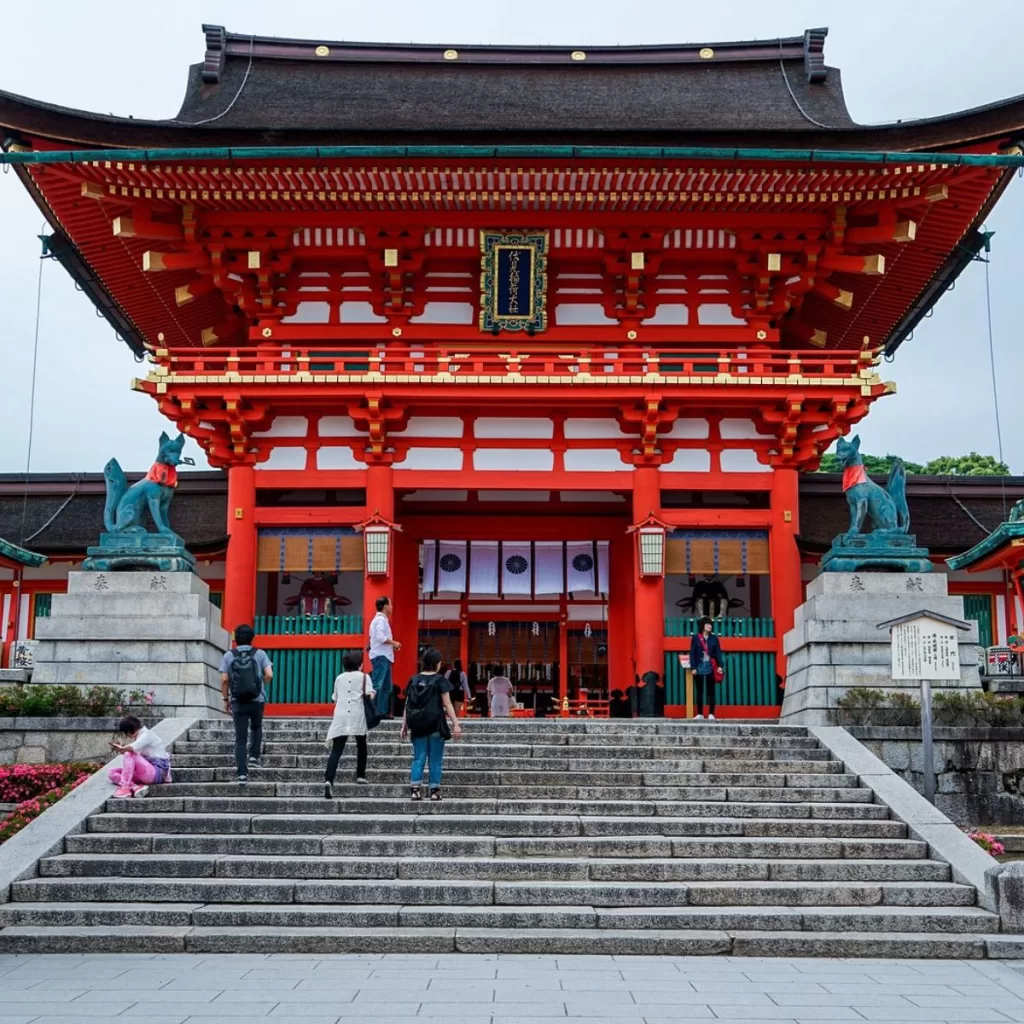
The iconic Fushimi Inari Shrine, with its thousands of vermilion torii gates winding through the hills, is one of Kyoto’s most impressive sights. Walking along the 2.5 mile hike through the gates is an unforgettable experience. It takes about 2-3 hours to complete the uphill hike to the summit of Mt. Inari, which offers panoramic views of Kyoto. The tourist attraction is the main home of Japan’s god of rice and sake, Inari.
It is widely known and recognized for its iconic rows of thousands of vibrant vermilion torii gates, which create a mesmerizing pathway through the sacred Mount Inari. The shrine is dedicated to the Shinto deity Inari, the god of rice and fertility. Visitors often embark on a memorable journey, walking through the torii gates and ascending the mountain trails, offering picturesque views of Kyoto along the way.
Whether one seeks a spiritual journey, wishes for good fortune, or simply wants to soak in the beauty of the shrine, Fushimi Inari Shrine provides a memorable and enchanting experience that embodies the allure and cultural significance of Kyoto. It’s definitely one of the best places to visit in Kyoto.
Kinkakuji (Golden Pavilion)
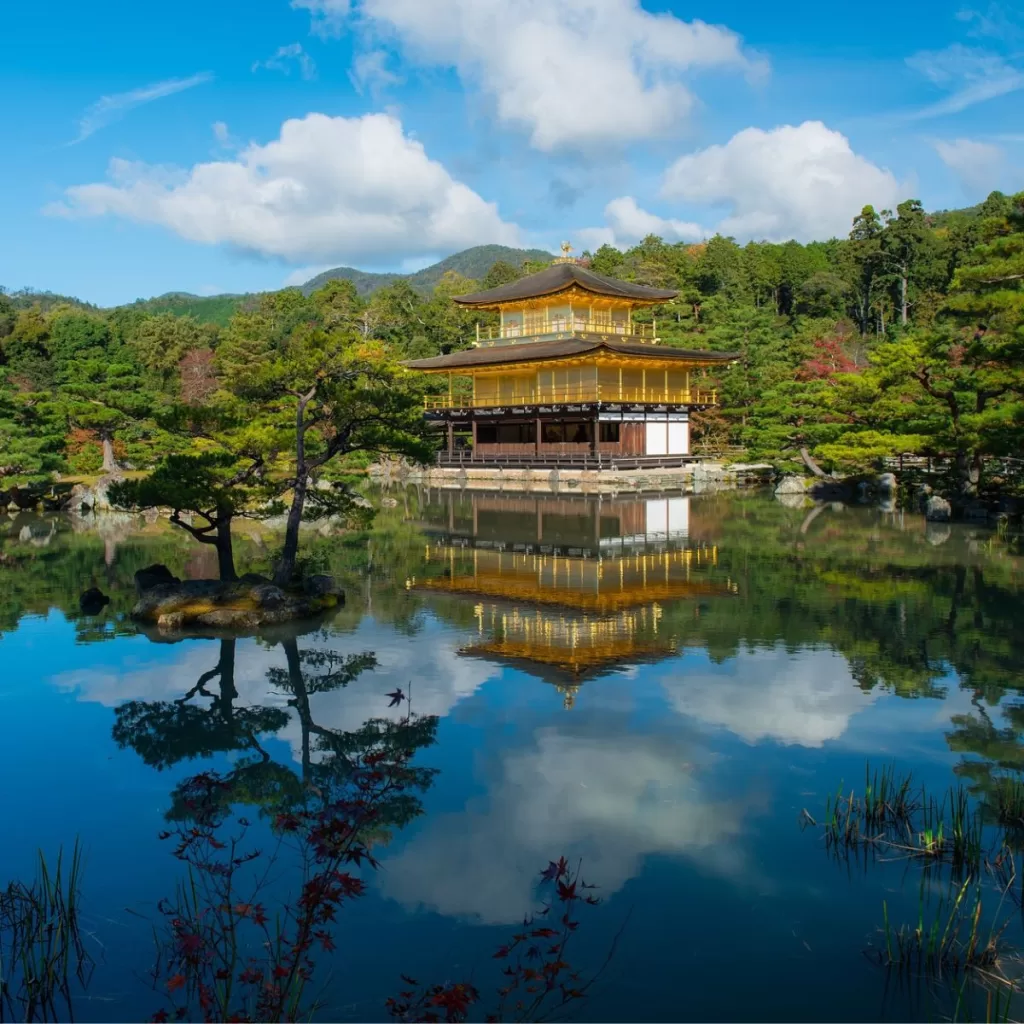
Kinkakuji, also known as the Golden Pavilion, is a Zen temple whose top two floors are completely covered in gold leaf. It is also considered one of the best tourist attractions in Kyoto. Surrounded by a beautiful garden, the golden temple shining over its reflection in the pond is a mesmerizing sight. This must-see Kyoto landmark attracts crowds, so it’s best to arrive early.
Exploring the meticulously landscaped gardens surrounding Kinkakuji is a serene and rejuvenating experience. The temple is situated on the edge of a peaceful pond, reflecting the magnificent golden pavilion and surrounded by beautiful nature. Strolling through the immaculate gardens, you’ll encounter beautiful cherry and maple trees, serene tea houses, and manicured rock formations, all carefully designed to provide a sense of harmony and tranquility.
A visit to Kinkakuji allows you to immerse yourself in Japan’s rich history and artistic heritage. The temple’s revered status and architectural grandeur make it a must-visit destination for both locals and international visitors. Prepare to be captivated by the stunning golden facade, inspired by the serene Zen gardens, and leave with a sense of peace and awe. Kinkakuji truly embodies the essence of Kyoto, and a visit here is a cherished memory you’ll carry with you for a lifetime.
Gion District
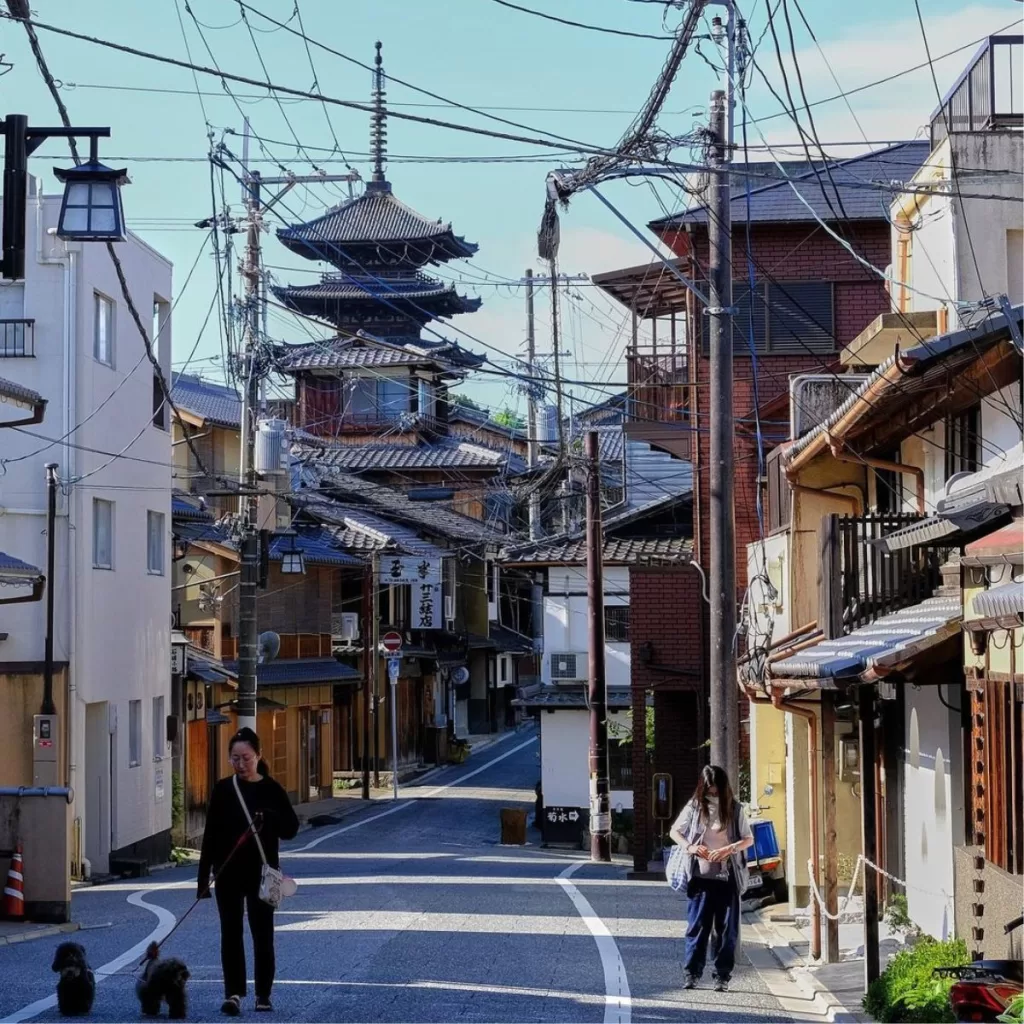
For a glimpse of traditional Kyoto, visit the atmospheric Gion district, one of the best tourist spots in Kyoto. With its narrow, cobblestone alleyways and wooden machiya merchant houses, Gion is the famous geisha district. Take an evening stroll, and you may spot a geisha in their beautiful kimono shuffling between the ochaya (teahouses).
Gion is renowned as the center of Kyoto’s geisha culture, and walking through its streets, you may catch a glimpse of a geisha or maiko (apprentice geisha) in their exquisite traditional attire. Gion Corner, a cultural theater located in the district, offers performances where visitors can witness traditional Japanese arts such as tea ceremonies, flower arrangement, and traditional musical performances. It’s a unique opportunity to experience the refined arts that have been cherished for centuries.
Beyond geisha culture, Gion is home to numerous traditional tea houses, restaurants, and shops. Indulge in a traditional kaiseki meal, a multi-course dining experience that showcases the delicate flavors of Kyoto cuisine. Visit one of the many tea houses for a serene matcha tea ceremony, where you can sip on the rich and frothy green tea while admiring a beautifully manicured Japanese garden. Gion is also famous for its traditional handicrafts, such as pottery, textiles, and paper goods, offering visitors the perfect opportunity to find unique souvenirs.
Arashiyama Bamboo Grove

If you go to Kyoto, you should also see the beautiful Arashiyama Bamboo Grove, which is magical. The serene walk through the towering green bamboo stalks of Arashiyama Bamboo Grove is magical. The sound of the bamboo swaying in the wind and the filtered sunlight creates a peaceful atmosphere. The grove is particularly stunning in the early morning or late afternoon when the light glows through the bamboo.
The bamboo stalks soar high above, creating a mesmerizing sight that will leave you in awe of nature’s beauty. The path weaves its way through the grove, inviting you to explore and discover the tranquility that lies within.
Arashiyama Bamboo Grove is a truly remarkable destination that captivates visitors with its natural beauty and serene ambiance. Experience the awe-inspiring sight of the towering bamboo stalks, immerse yourself in the tranquility of the forest, and explore the surrounding attractions that make Arashiyama a must see spot in Kyoto.
Nijo Castle
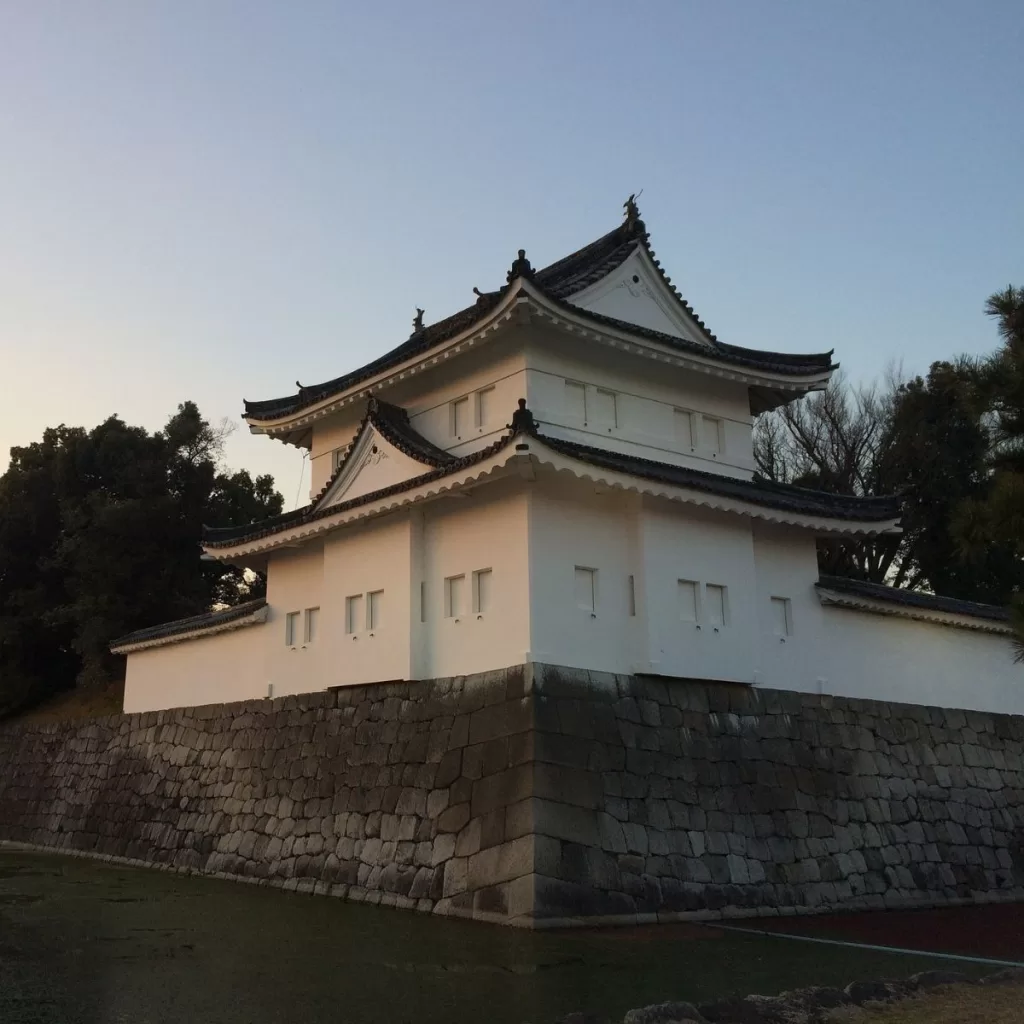
Originally built in 1603, Nijo Castle was the Kyoto residence of the first Tokugawa Shogun. The castle displays the power and wealth of the shoguns with its lavish interiors, nightingale floors, hidden chambers, and spacious Ninomaru Garden. The castle illuminates the history of Japan’s feudal era and provides insight into the life of the shoguns.
The highlight of Nijo Castle is the Ninomaru Palace, an exquisite example of Japanese architecture and design. As you walk through its corridors and rooms, adorned with intricately painted sliding doors and polished wooden floors that chirp under your footsteps, you will be captivated by the beauty and attention to detail. The palace features stunning gardens, serene ponds, and charming teahouses that provide a serene backdrop to the elegant interiors.
A visit to Nijo Castle allows you to step into the past and marvel at the architectural and historical significance of this majestic fortress. Immerse yourself in the opulent surroundings, explore the lush gardens, and gain a deeper understanding of Japan’s rich cultural heritage. For those fascinated by history, architecture, and the aura of a bygone era, Nijo Castle is an essential destination in Kyoto that promises a memorable and educational experience. Nijo Castle is one of the must-see attractions in Kyoto.
Kiyomizudera
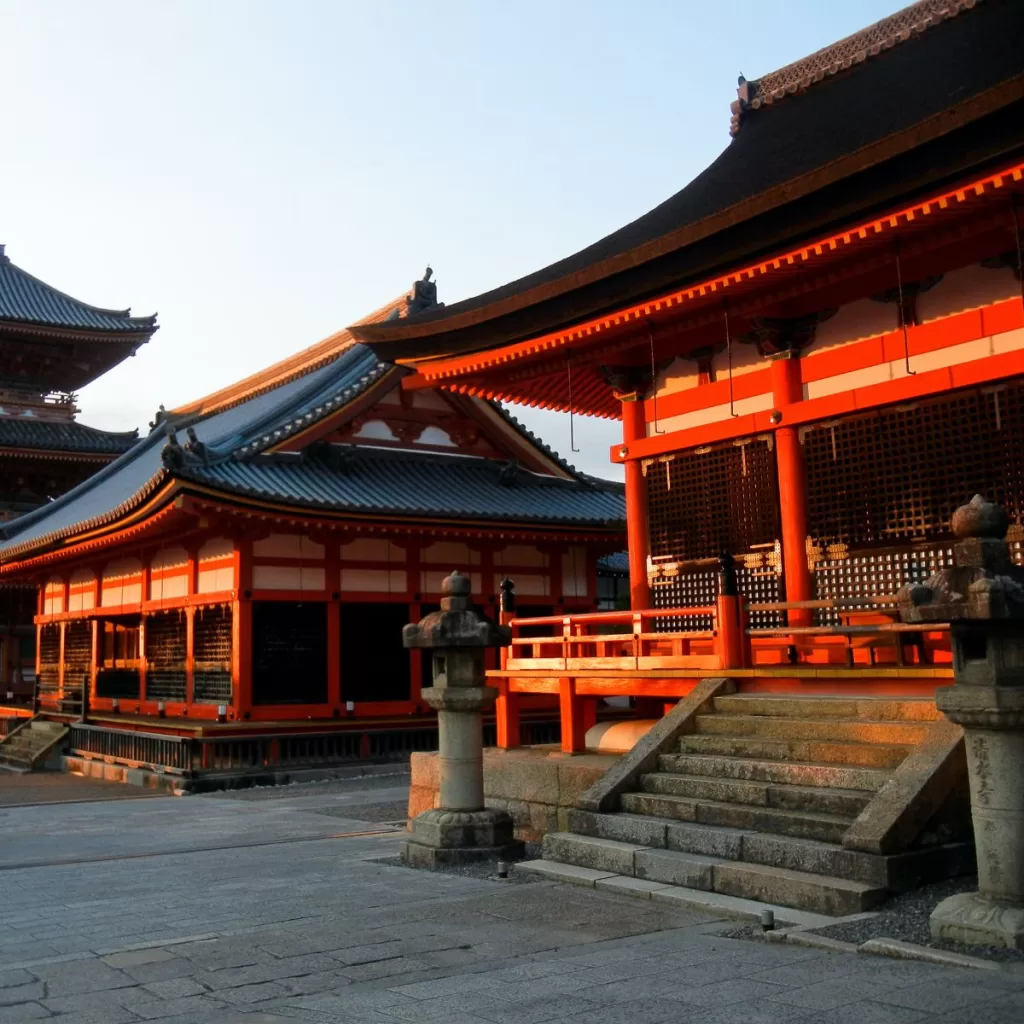
Another best spot is Kiyomizudera. The beautiful wooden temple of Kiyomizudera is one of eastern Kyoto’s most popular sites. Built in 780 AD without the use of nails, the temple has panoramic views of Kyoto from its main hall’s large veranda. In spring, the temple’s hillside location provides a great view of Kyoto’s famous cherry blossoms.
Nestled amidst the lush Higashiyama mountains, this UNESCO World Heritage Site offers visitors a captivating blend of ancient architecture, serene gardens, and deep spiritual significance.
As you ascend the temple grounds, you’ll be greeted by the impressive wooden structure that stands on stilts, offering breathtaking panoramic views of the surrounding cityscape. The main hall’s intricate design and craftsmanship are a testament to the skill and artistry of Japan’s traditional architecture. It’s one of the best Kyoto tourist attractions.
Ginkakuji (Silver Pavilion)
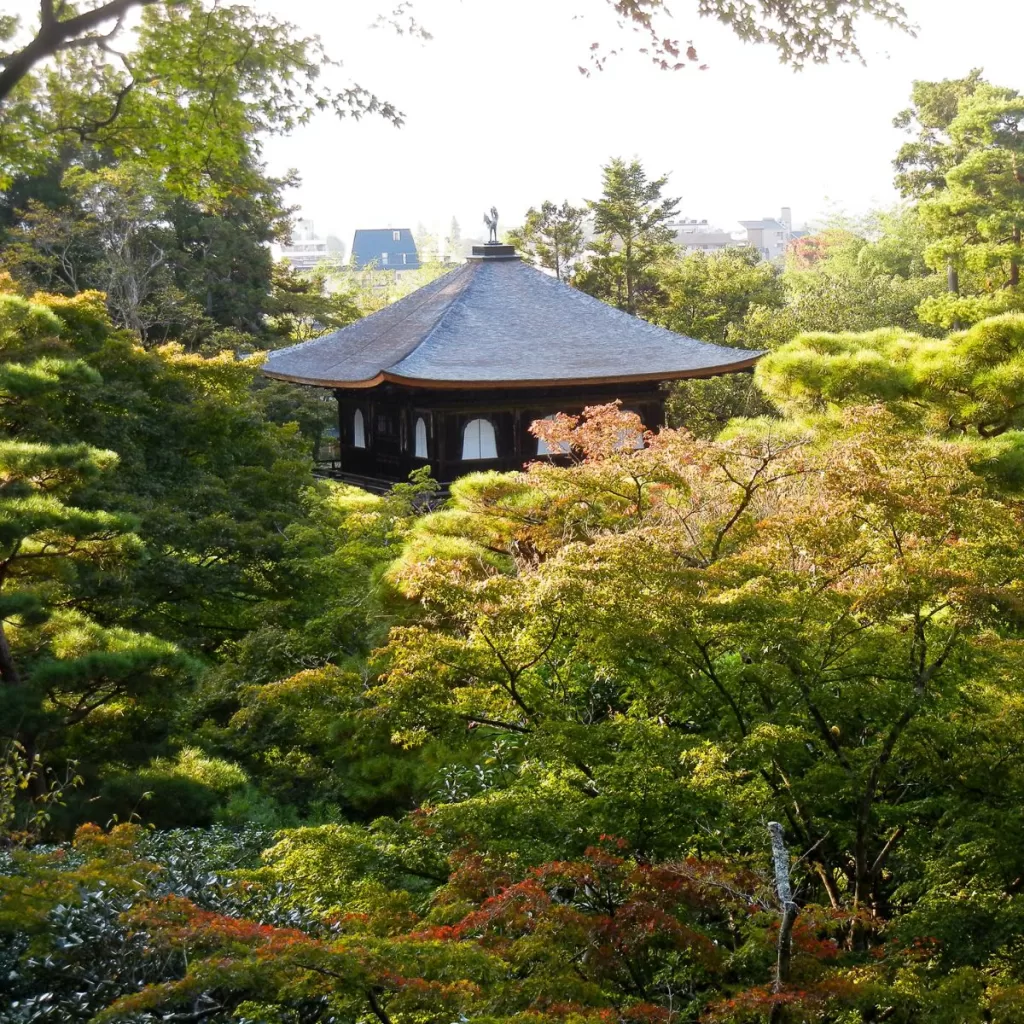
Modeled after Kinkakuji, Ginkakuji, also called the Silver Pavilion, is a Zen temple with a tranquil moss garden and elegant traditional architecture. Although the Silver Pavilion is not covered in silver like its golden counterpart, its garden and hillside scenery make it one of Kyoto’s top destinations.
The Silver Pavilion is best known for its stunning garden, meticulously designed to embody the aesthetics of simplicity and harmony. As you stroll through the carefully raked sand, admire the perfectly placed rocks, and meditate by the tranquil pond, you’ll feel a sense of peace and serenity wash over you.
The garden’s seasonal beauty, including cherry blossoms in spring and vibrant foliage in autumn, adds to the enchantment of Ginkakuji and makes it a favorite spot for photographers and nature enthusiasts alike.
Philosopher’s Walk
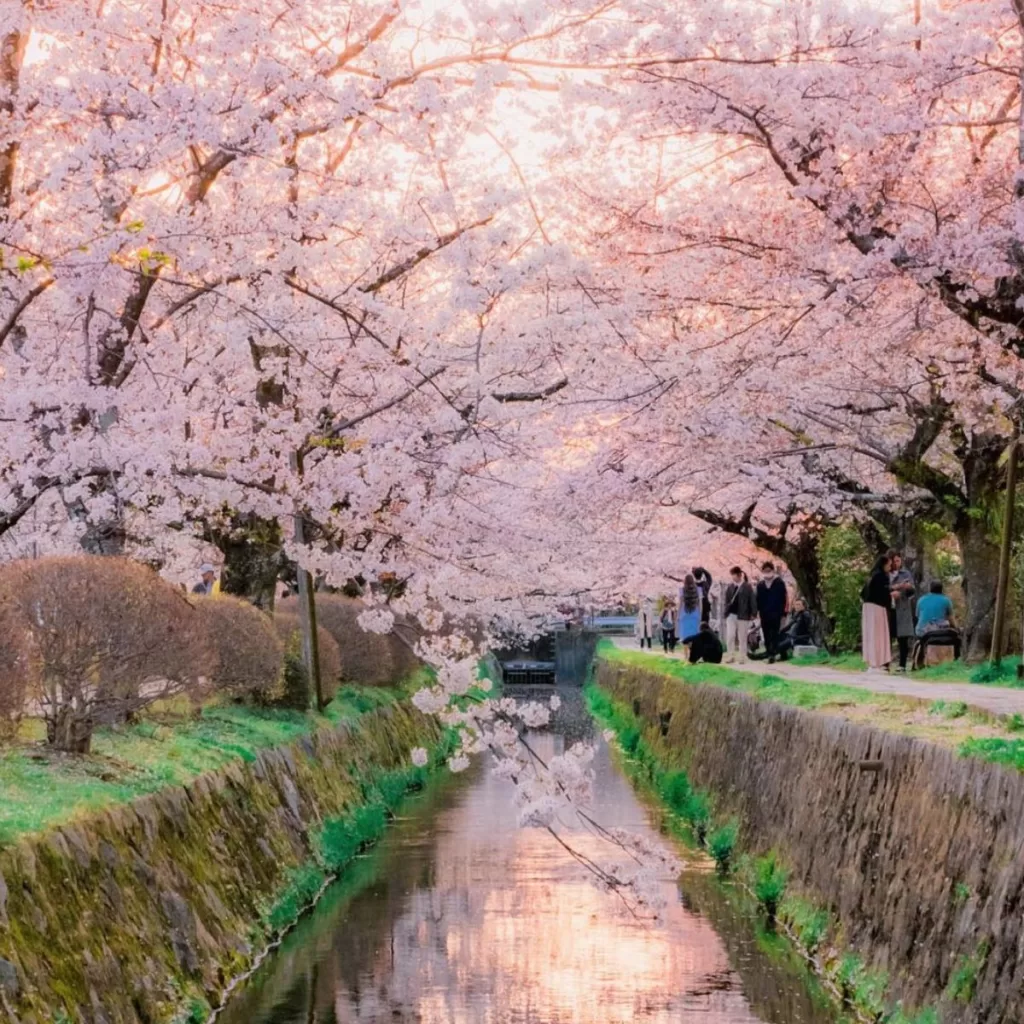
Kyoto also has the Philosopher’s Walk. Stretching between Ginkakuji and Nanzenji Temple, Philosopher’s Walk is a pleasant stone path following a canal lined with cherry trees. The scenic walk gets its name from a 20th-century Kyoto University philosophy professor who frequented it. It’s a nice way to connect temples while enjoying nature.
The Philosopher’s Walk offers a unique combination of nature, history, and culture. As you stroll along the canal, you’ll pass by quaint shops, traditional teahouses, and small temples that add to the traditional charm of the area. The tranquil atmosphere and lush greenery create a soothing ambiance, inviting visitors to slow down, reflect, and appreciate the simple joys of life. It’s no wonder the Philosopher’s Walk has long been a source of inspiration for artists, writers, and thinkers.
The Philosopher’s Walk is best experienced during cherry blossom season, when the trees that line the canal burst into a delicate sea of pink. The breathtaking sight of sakura petals gently falling into the water creates a poetic scene that is truly enchanting. However, the beauty of this trail transcends any particular season. Each season brings its own unique charm, from vibrant foliage in autumn to serene snow-covered landscapes in winter.
Nishiki Market
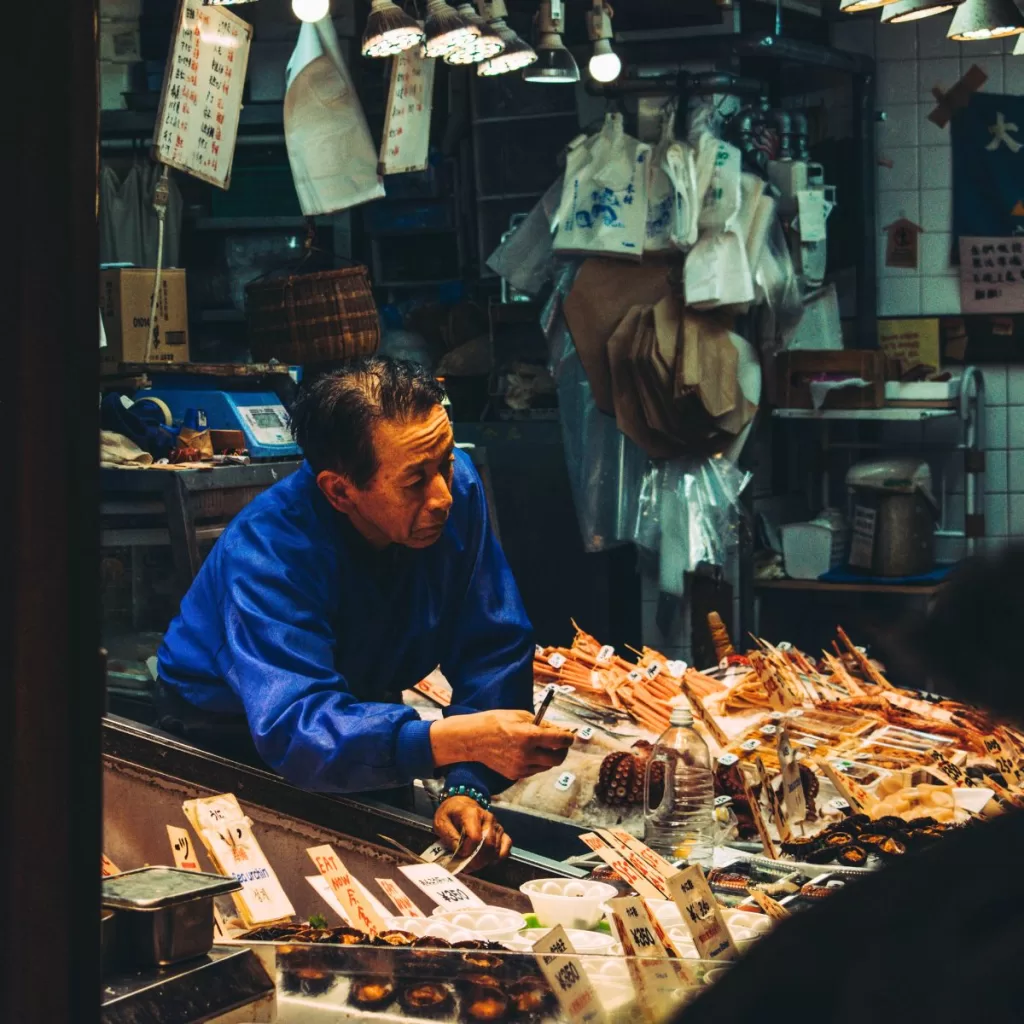
For delicious street food, shopping, and immersion in local Kyoto culture, visit the lively Nishiki Market, one of the most popular Kyoto attractions. It is known as “Kitchen of Kyoto”, the covered market street has fresh seafood, produce, knives, and Japanese sweets. It’s a great place to try authentic culinary specialties like takoyaki octopus balls.
Nishiki Market is a paradise for food lovers, offering a wide variety of gastronomic delights. From fresh seafood, locally grown produce, and artisanal pickles to delectable street food and mouthwatering sweets, there is something to satisfy every palate.
Don’t miss the opportunity to sample Kyoto specialties such as yudofu (tofu hot pot), kaiseki (traditional multi-course meal), and matcha-flavored treats. Engage with the local vendors, learn about their products, and savor the unique flavors that Kyoto has to offer. Your Kyoto travel will definitely be memorable.
Fushimi Sake District
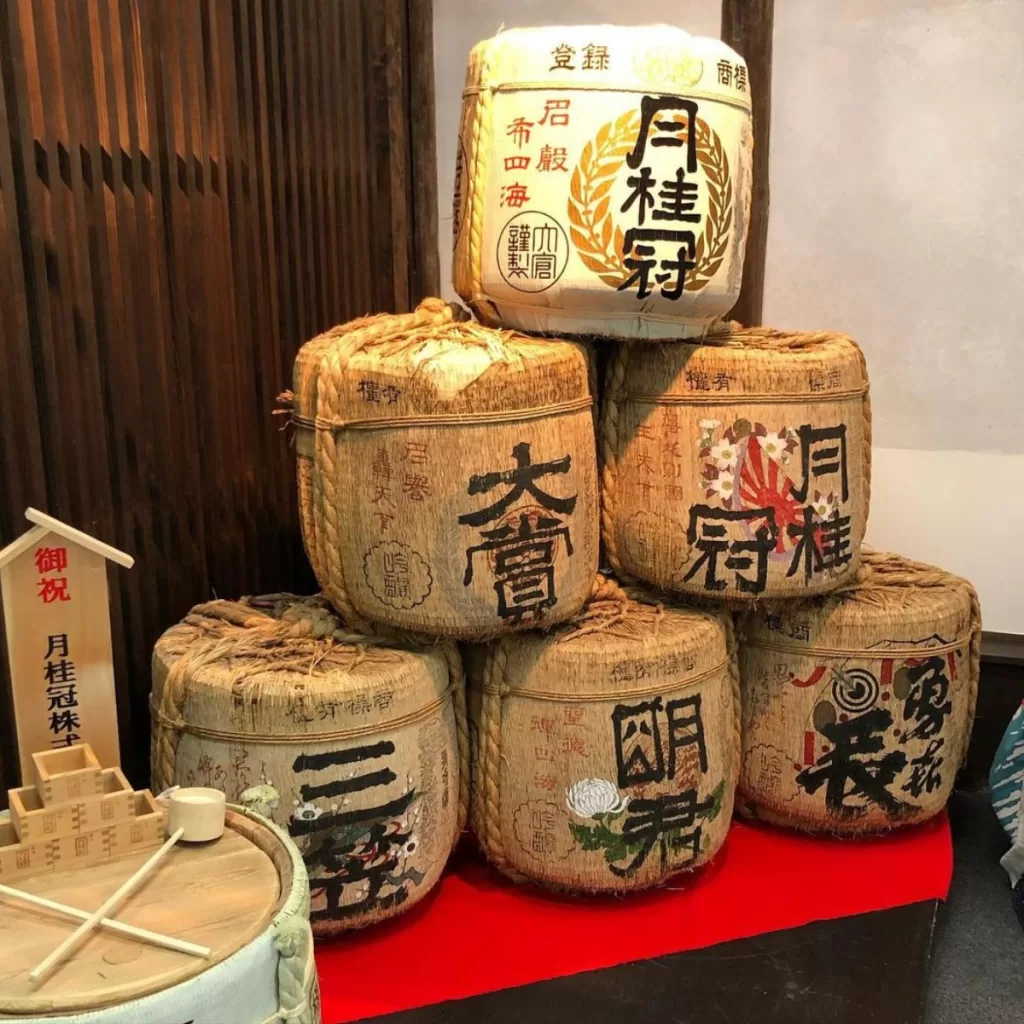
Fushimi is considered one of the top sake producing regions in Japan. Its historic sake breweries and shops along the canal create the Fushimi Sake District. Take a stroll along the canal to sample different sake varieties and learn about sake production. Don’t miss the Gekkeikan Okura Sake Museum.
With its traditional breweries, picturesque streets, and immersive tasting experiences, the Fushimi Sake District is a must-visit destination for sake enthusiasts and those interested in exploring the art and craftsmanship behind this iconic Japanese beverage.
As you stroll through the streets of the Fushimi Sake District, you’ll be captivated by the sight of traditional wooden buildings housing sake breweries. These breweries have been honing their craft for centuries, using time-honored techniques passed down through generations. Take a guided tour and learn about the sake-making process, from the cultivation of the rice to the fermentation and aging that results in the exquisite flavors of sake. With each step, you’ll gain a deeper appreciation for the dedication and precision involved in creating this iconic beverage.
Monkey Park Iwatayama
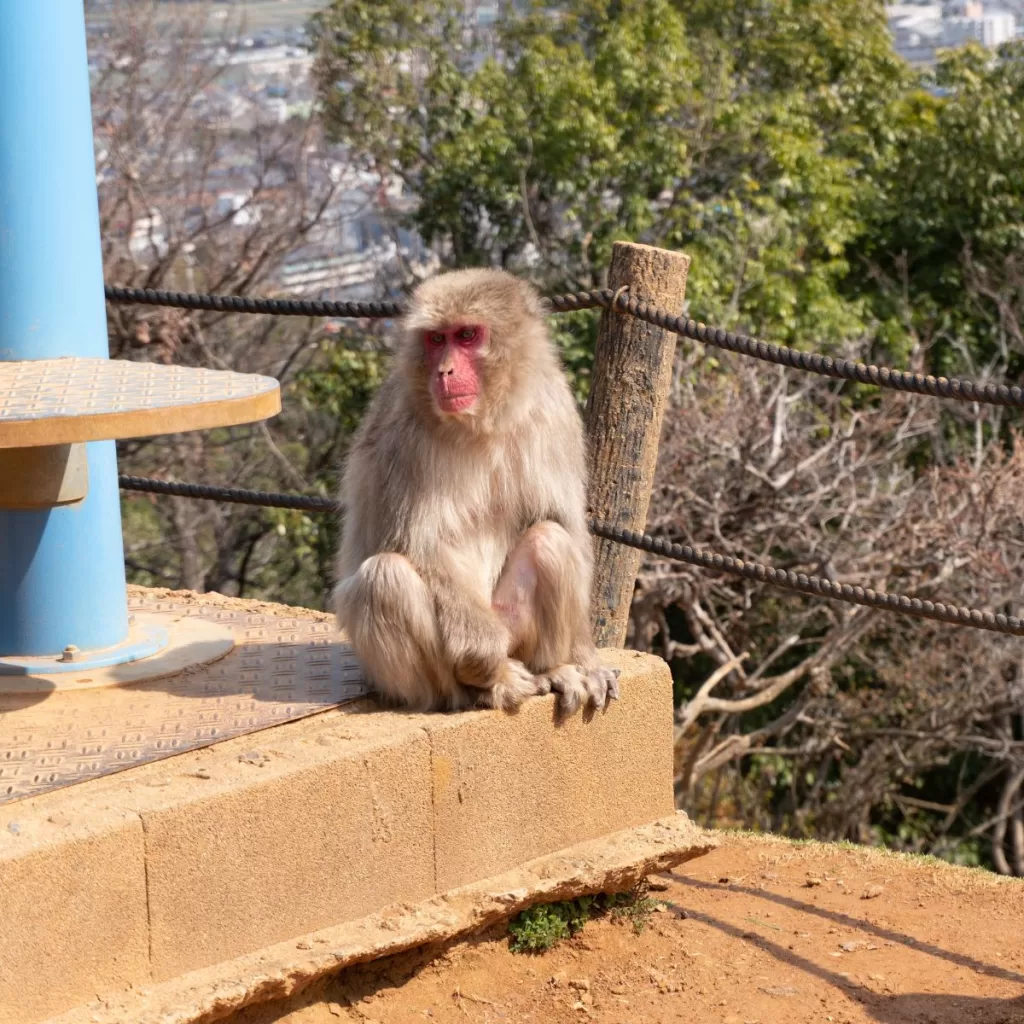
A hidden gem nestled in the scenic Arashiyama region of Kyoto. This unique park offers visitors a once-in-a-lifetime opportunity to observe and interact with Japanese macaques, known as snow monkeys, in their natural habitat.
As you embark on the hike up to Monkey Park Iwatayama, be prepared to be immersed in a world of playful monkeys and breathtaking scenery. The trail leads you through a serene bamboo forest, creating a sense of tranquility and anticipation. Once you arrive at the park, you’ll be able to observe the monkeys up close as they roam freely in their natural habitat.
At the Arashiyama Monkey Park, you can feed and observe a troop of over 100 free-roaming Japanese macaques. Watch in awe as they interact, groom each other, and display their charming antics. For a unique experience, you can also purchase food to feed the monkeys, who may eagerly approach you with their curious and endearing personalities.
Kamigamo Shrine
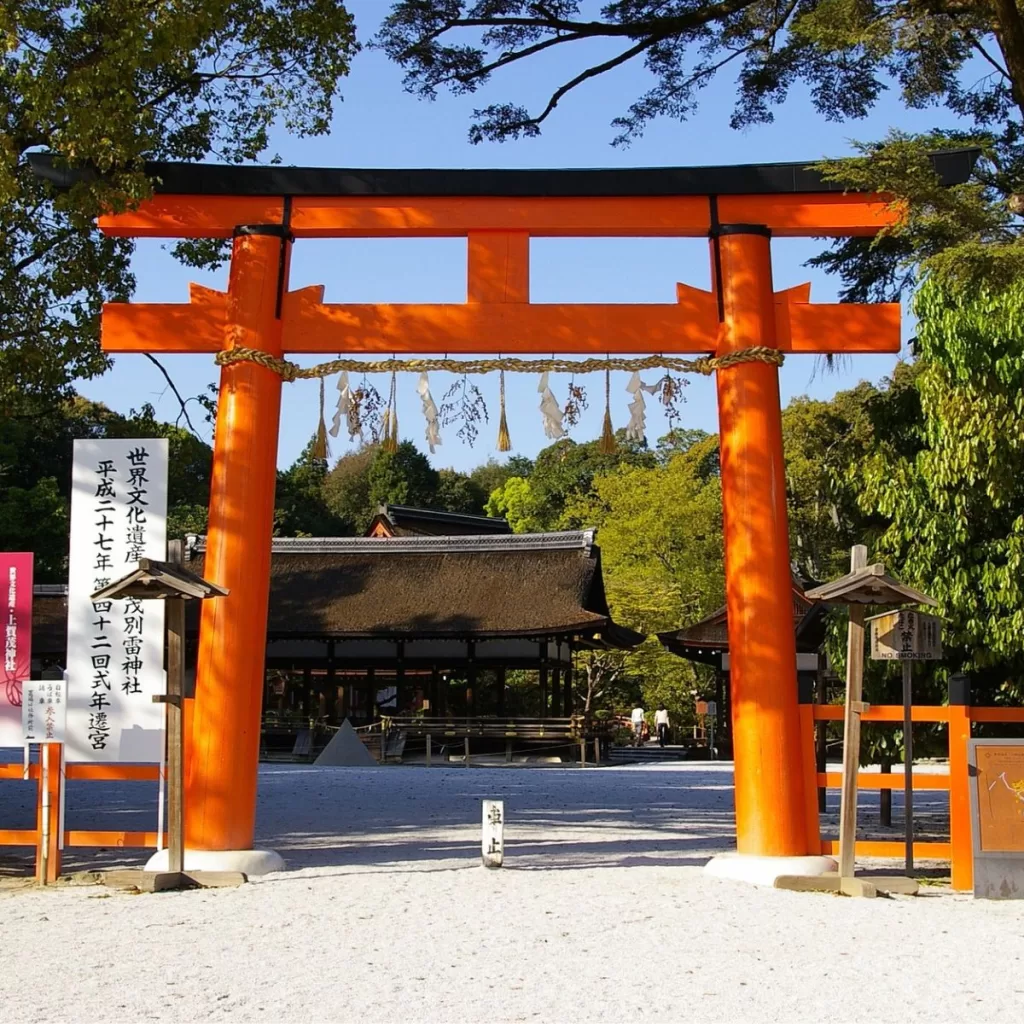
Considered one of Japan’s oldest and most important Shinto shrines, Kamigamo Shrine was founded in 678. Dedicated to rice and fertility, the shrine performs many ceremonial rituals. With its sand cones, wooded areas, and sanctuaries, Kamigamo Shrine provides a peaceful, spiritual experience. It’s one of the most popular tourist destinations in Kyoto.
Kamigamo Shrine is not only a place of worship but also a cultural hub that hosts traditional ceremonies, festivals, and events throughout the year. The most renowned festival is the Kamigamo Shrine Yabusame, where expert archers on horseback showcase their exceptional skills in a thrilling display of precision and horsemanship. Attending one of these events offers a glimpse into the vibrant traditions and rituals that have been passed down through generations, allowing visitors to truly immerse themselves in the cultural fabric of Kyoto.
A visit to Kamigamo Shrine is a journey into the heart and soul of Japan. Experience the power of ancient rituals, marvel at the architectural wonders, and connect with the natural beauty that surrounds this sacred site. Whether you’re seeking a spiritual retreat, cultural exploration, or a moment of tranquility, Kamigamo Shrine is a destination that will leave you with a profound appreciation for the rich tapestry of Japanese traditions and the enduring legacy of this historic place.
Ryoanji Temple
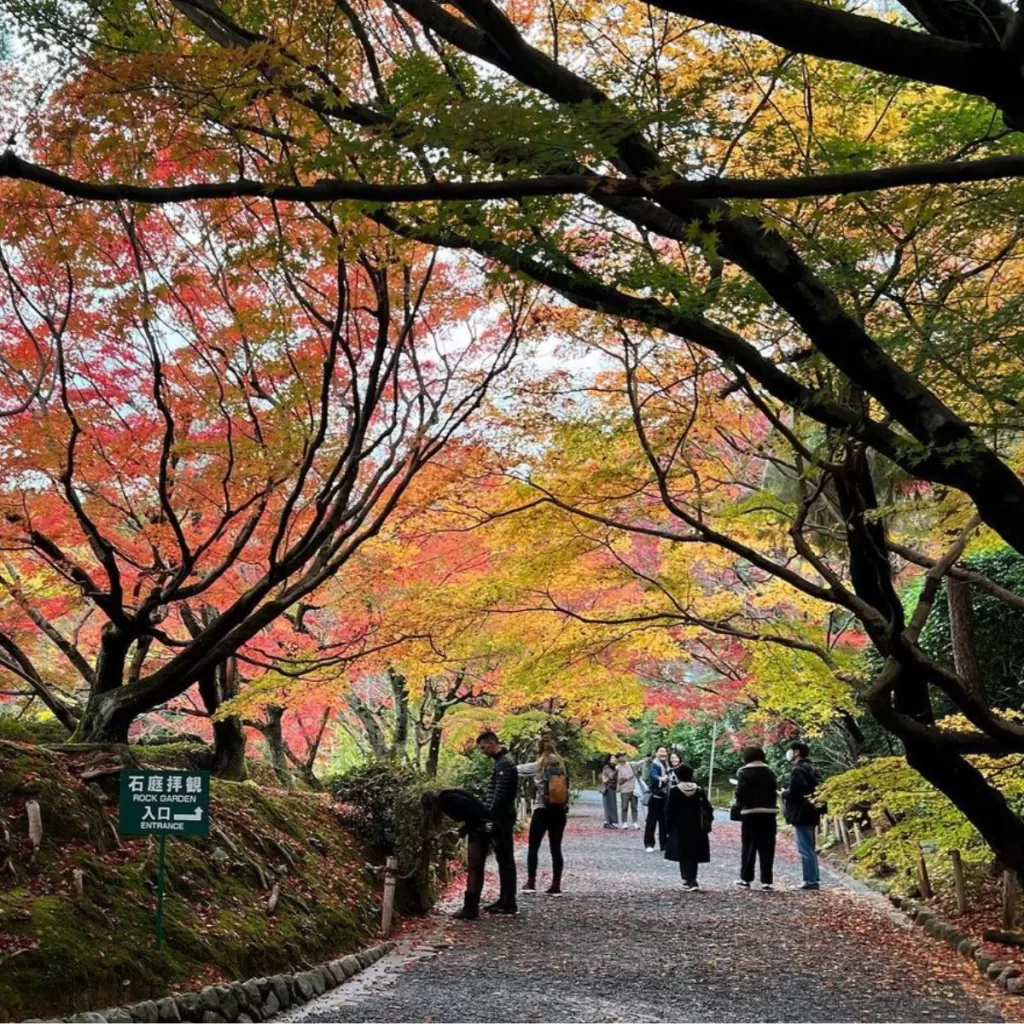
Explore the best of Ryoanji Temple. Home to Japan’s most famous zen rock garden, Ryoanji Temple draws visitors who come to ponder the meaning of its meticulously raked gravel and 15 rocks. The mysterious and minimalist dry landscape garden designed in the late 1400’s allows for meditation. The temple’s beauty lies in the illusion, artistry, and interpretations of its simple elements.
The rock garden is believed to be a representation of a meditative state, with each stone strategically placed to create a composition that inspires introspection and reflection.
A visit to Ryoanji Temple is an invitation to pause, reflect, and find solace in the simplicity of the surroundings. Whether you’re a student of Zen Buddhism, an avid gardener, or simply in search of a serene escape, Ryoanji Temple offers a sanctuary of peace and tranquility amidst the busyness of the world.
Sanjusangendo Hall
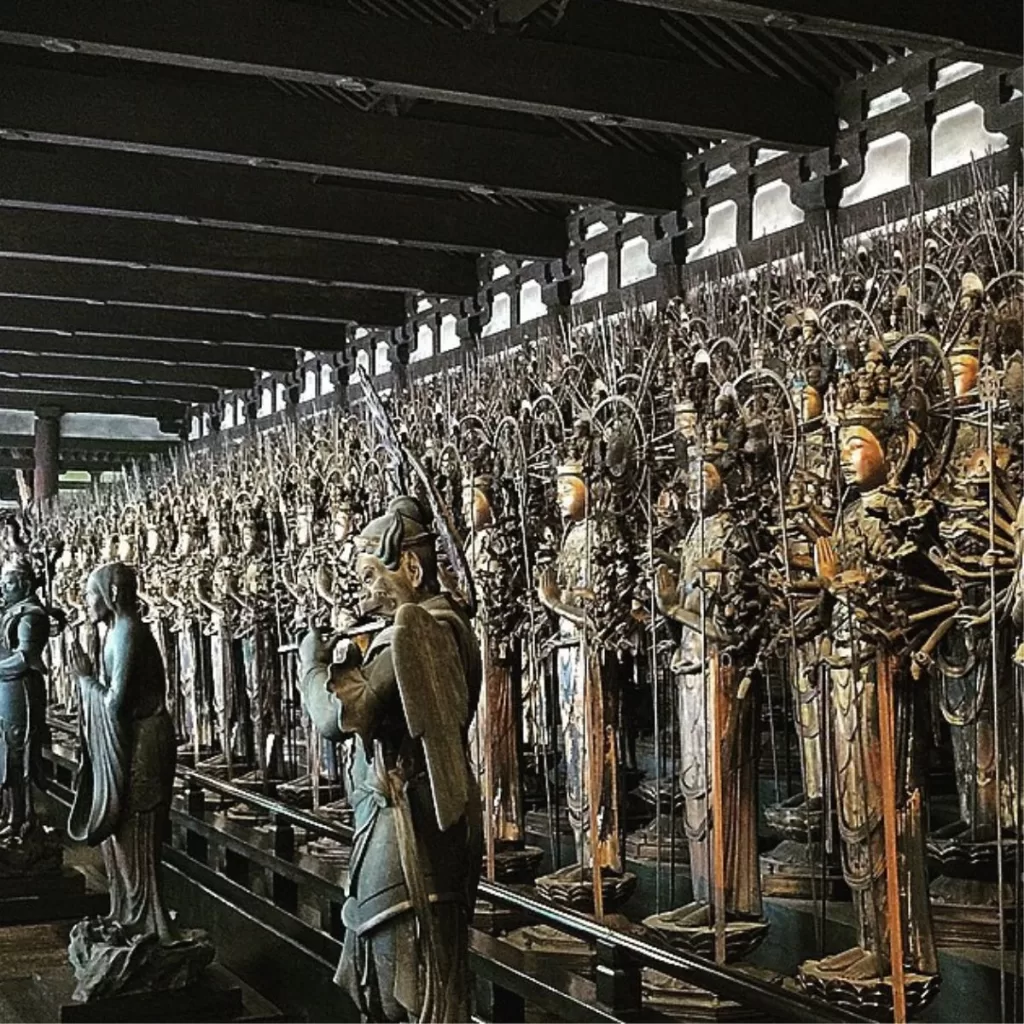
Sanjusangendo Hall houses 1,001 eerily lifelike statues of Kannon, the goddess of mercy. The rows of golden statues, ranging from life-size to nearly 25 feet, are an impressive sight. At nearly 400 feet long, Sanjusangendo Hall claims to be the longest wooden structure in Japan. Outside of visiting hours, visitors can practice Kyudo, or Japanese archery.
The statues in Sanjusangendo Hall are intricately carved and expertly crafted, each displaying its own unique expression and pose. As you walk along the wooden corridor that surrounds the hall, you’ll have the opportunity to observe every individual statue up close, marveling at the astonishing level of detail and artistry involved in their creation.
Beyond the exquisite statues, the hall itself is a masterpiece of architectural design. The long wooden structure features a traditional Japanese style with gracefully curved roofs and elegant open spaces. The interior of the hall is adorned with exquisite artwork, from intricate carvings to vibrant paintings that depict scenes from Buddhist mythology.
Shoren-in Temple
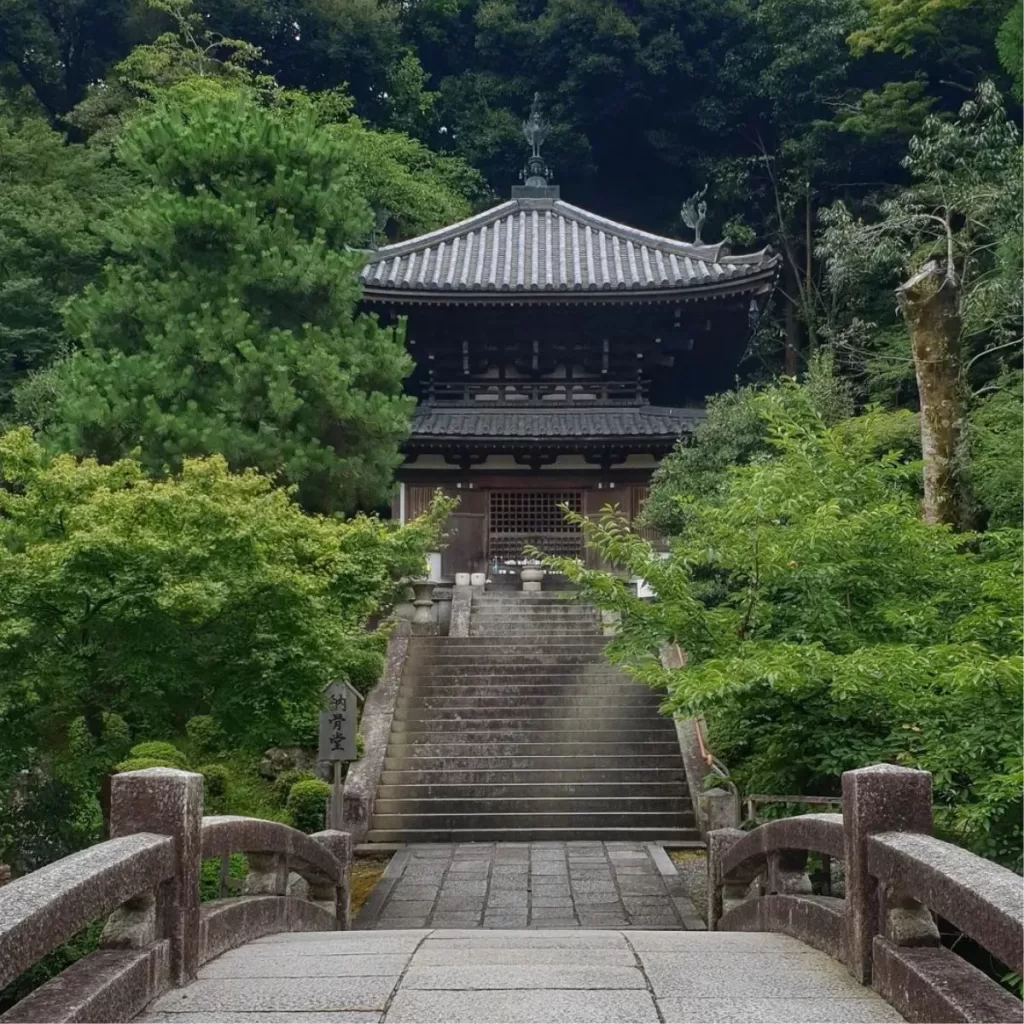
Nestled in the hills, Shoren-in Temple’s elegant architecture and sprawling gardens exude tranquility. Admire the pink spring blossoms against a backdrop of vibrant green moss and serene rock gardens. The temple offers the unique opportunity to stay overnight and experience morning prayers and rituals.
As you enter the temple grounds, you’ll be greeted by a gorgeous Japanese garden that exudes a sense of peace and harmony. Take a leisurely stroll along the meandering paths, adorned with lush foliage and picturesque ponds, as you soak in the beauty of nature and find respite in its tranquil ambiance.
The main highlight of Shoren-in Temple is the beautiful Hoshinoya-style garden that offers breathtaking views and a place for meditation. Explore the traditional architecture of the temple buildings, characterized by elegant shoji sliding doors and tatami flooring. Admire the exquisite artwork on the sliding doors, showcasing scenes from nature and Japanese mythology. You may also have the opportunity to participate in a traditional tea ceremony, immersing yourself in the refined art of tea preparation while savoring the peaceful atmosphere.
Eikan-dō Zenrin-ji
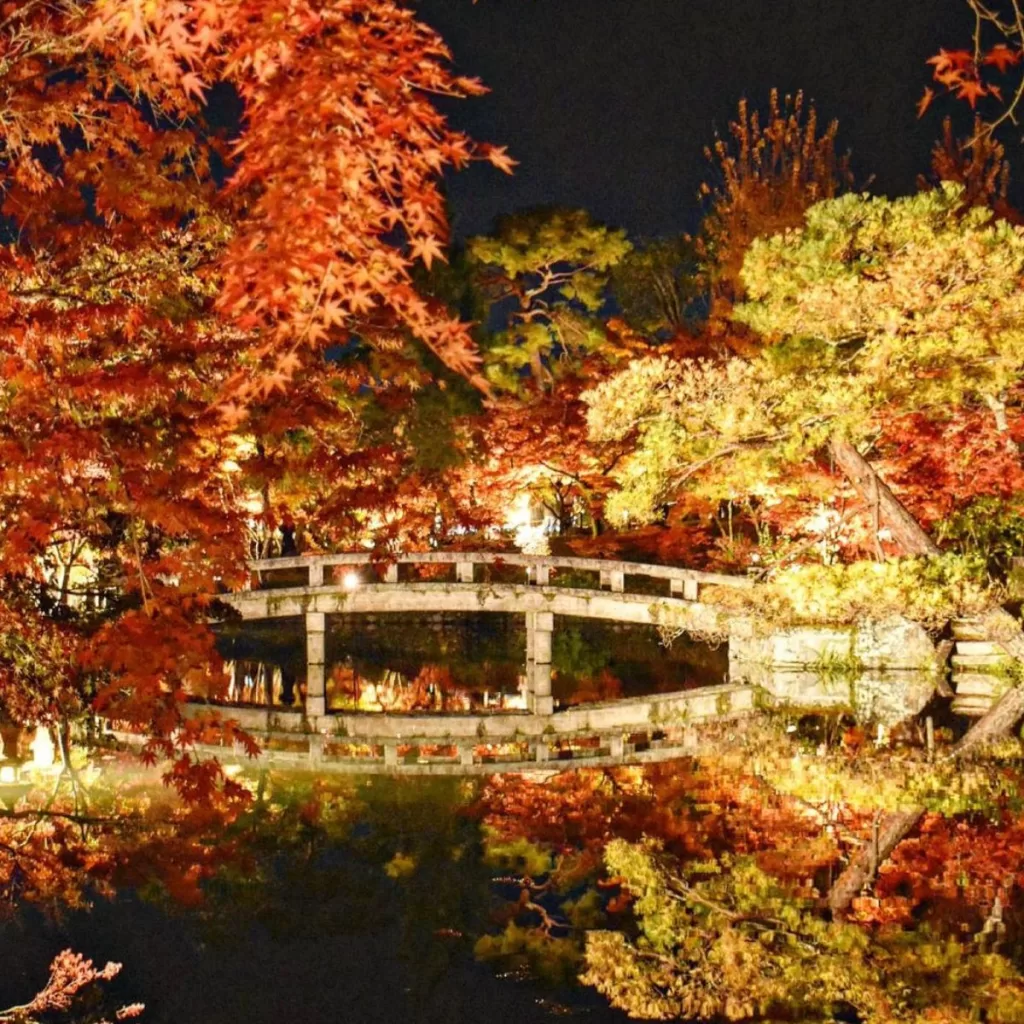
Kyoto’s hidden gem, Eikan-dō Zenrin-ji is a peaceful temple with gorgeous gardens, famous for its autumn colors. In November, the temple’s grounds display hues of bright yellow, orange, and red. Eikan-dō Zenrin-ji has interesting Buddha statue iconography and Impressionist-like paintings not found elsewhere in Kyoto.
Eikan-dō Zenrin-ji is not just a place of visual splendor but also a center for Zen Buddhist practice. Immerse yourself in the peaceful atmosphere as you explore the temple’s expansive gardens, tranquil ponds, and picturesque walking paths. Take a moment to sit and meditate in one of the temple’s quiet meditation halls, allowing the serenity of the surroundings to envelop you and cultivate a sense of inner calm.
Beyond the natural beauty, Eikan-dō Zenrin-ji is home to a treasure trove of cultural and historical artifacts. The temple houses an impressive collection of Buddhist statues, paintings, and calligraphy, offering visitors a glimpse into the rich artistic and religious heritage of Japan.
Heian Shrine
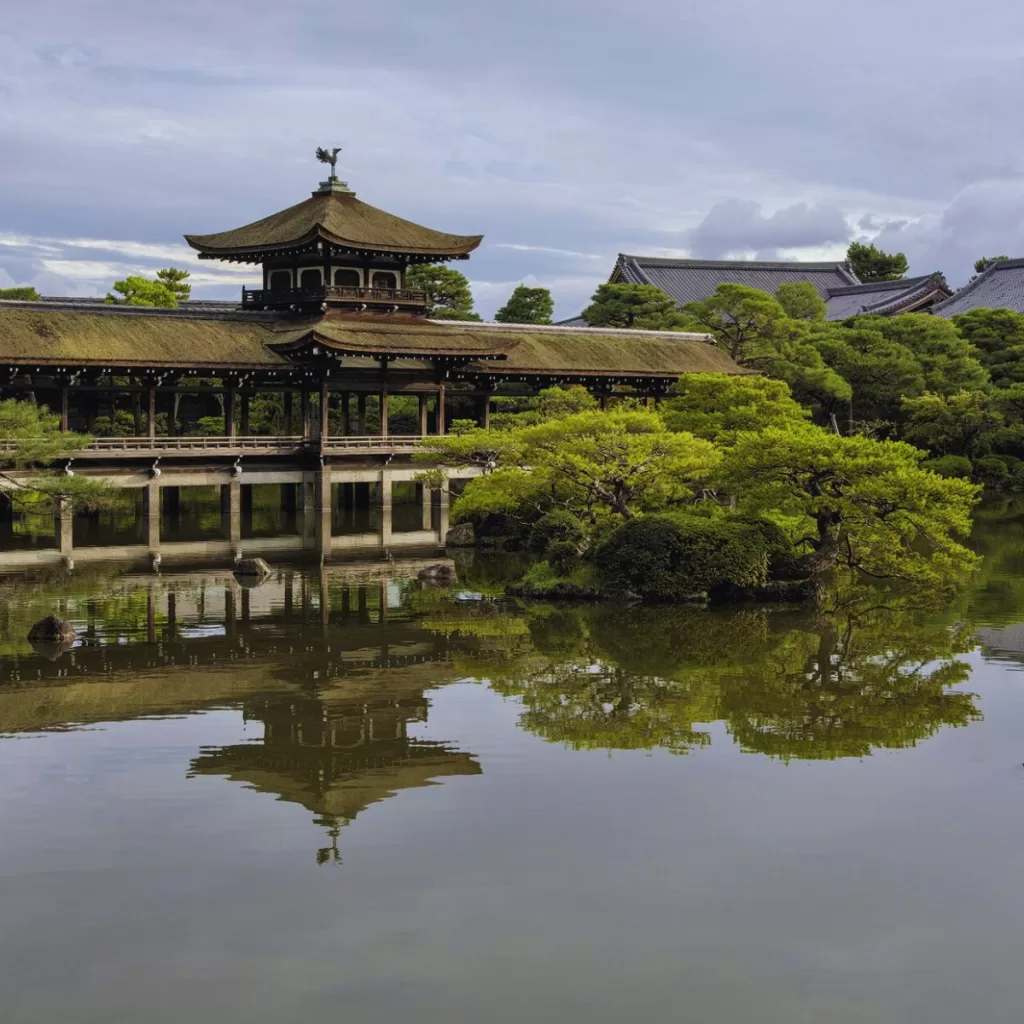
Completed in 1895, Heian Shrine, one of the most popular tourist attractions in Kyoto, commemorates the 1000th anniversary of Kyoto becoming Japan’s capital. The Shinto shrine boasts an enormous vermillion torii gate, its central courtyard is especially beautiful during cherry blossom season when its water gardens are vibrant with color.
One of the main highlights of Kyoto Heian Shrine is its breathtaking gardens, meticulously designed to showcase the beauty of each season. Explore the sprawling gardens adorned with vibrant flowers, perfectly manicured lawns, and serene ponds. During the cherry blossom season, the gardens are transformed into a sea of delicate pink blossoms, creating a picturesque setting that is simply enchanting.
Be sure to visit the Shin’en Garden, known for its stunning water features and lush greenery, providing a peaceful oasis in the heart of the city.
Kōdai-ji Temple
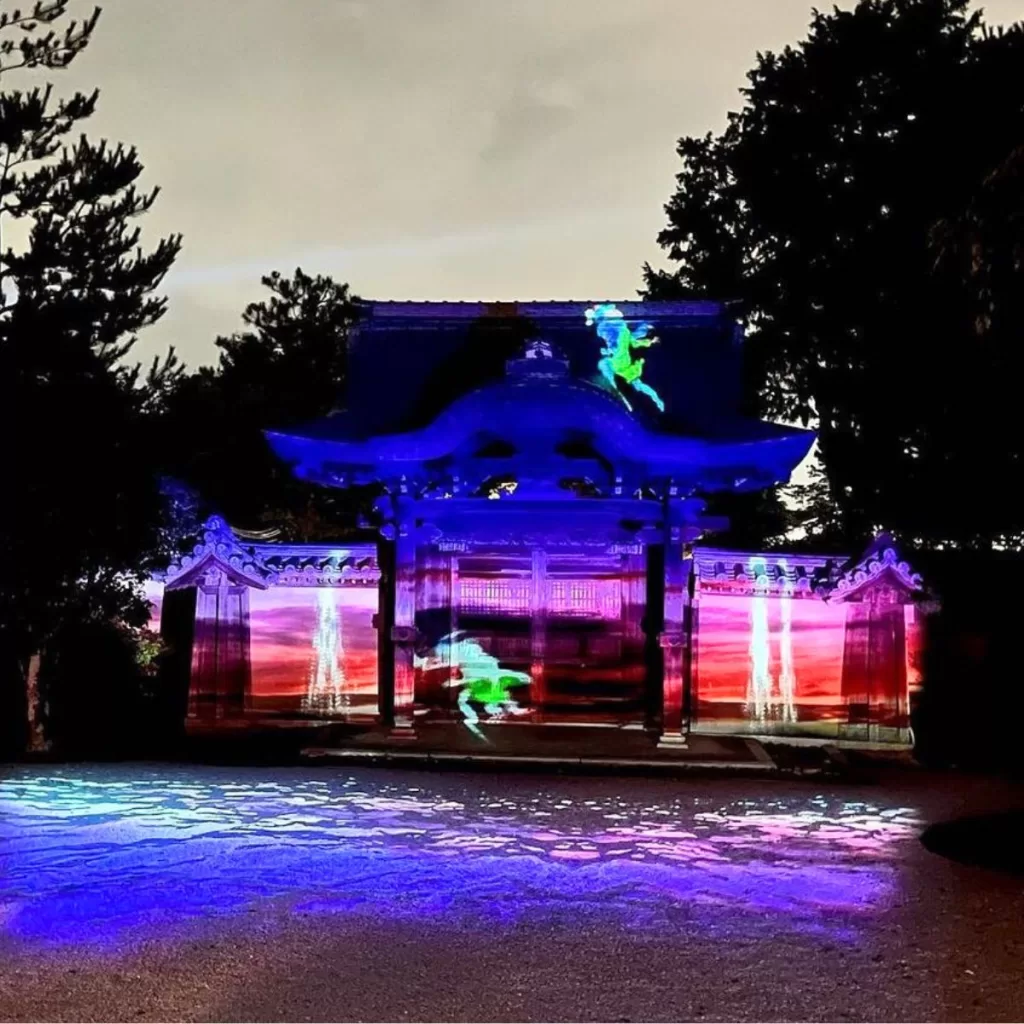
Kōdai-ji Temple was built by the widow of samurai and unifier of Japan, Toyotomi Hideyoshi, after his death in 1605. The temple buildings have historical and artistic significance, and there are scenic strolls through its gardens. Walking paths wind through groves with maple trees, azaleas, bamboo, and ponds.
A beautiful and peaceful sanctuary nestled in the mountains of Kyoto. This temple is a must-visit for anyone looking to experience the tranquility and beauty of Japanese culture. As you explore the temple grounds, you’ll be captivated by the stunning gardens and traditional architecture, which create a serene and serene atmosphere.
The gardens of Kōdai-ji Temple are simply breathtaking, with carefully trimmed trees, colorful flowers, and peaceful ponds. Take a leisurely stroll along the winding paths, allowing the serenity of the surroundings to relax your mind and uplift your spirit.
Kyoto Imperial Palace
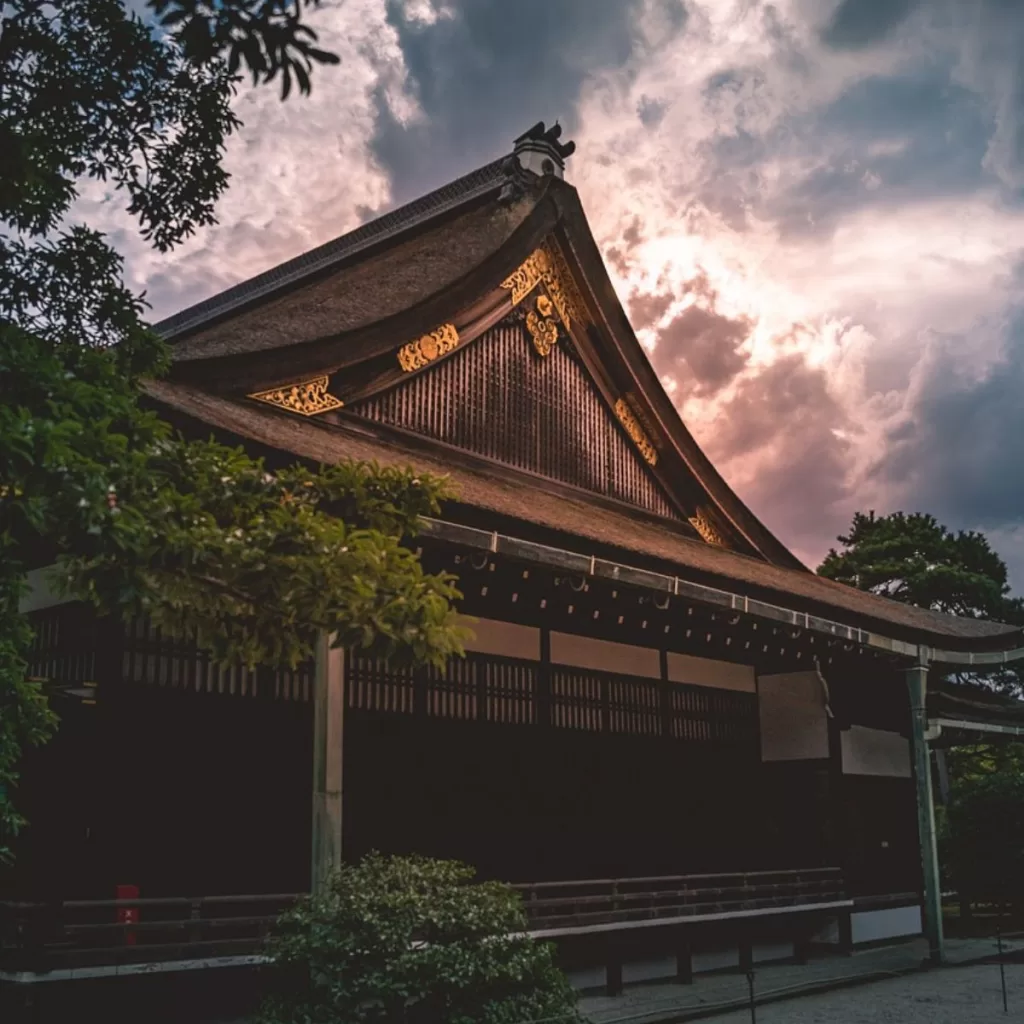
The Kyoto Imperial Palace is the former ruling palace of Japan’s Imperial Family until 1868, when Tokyo became the capital. The palace’s immaculate architecture and sprawling park grounds offer an escape from the bustling city. Visit the Imperial Household Agency to join a free tour and explore a small portion of the palace.
As you step into the palace grounds, you’ll be transported to a different era, surrounded by beautiful gardens and magnificent buildings. The palace served as the residence for the Imperial family for centuries and remains a significant symbol of Japanese culture and tradition.
Explore the sprawling gardens of Kyoto Imperial Palace, filled with serene ponds, lush greenery, and meticulously manicured landscapes. Take a leisurely walk along the peaceful paths, breathing in the fresh air and taking in the beauty of nature. Admire the impressive architecture of the palace buildings, characterized by elegant details and traditional Japanese design elements. The palace offers guided tours that provide valuable insights into the history and cultural significance of the site.
Tenryu-ji Temple
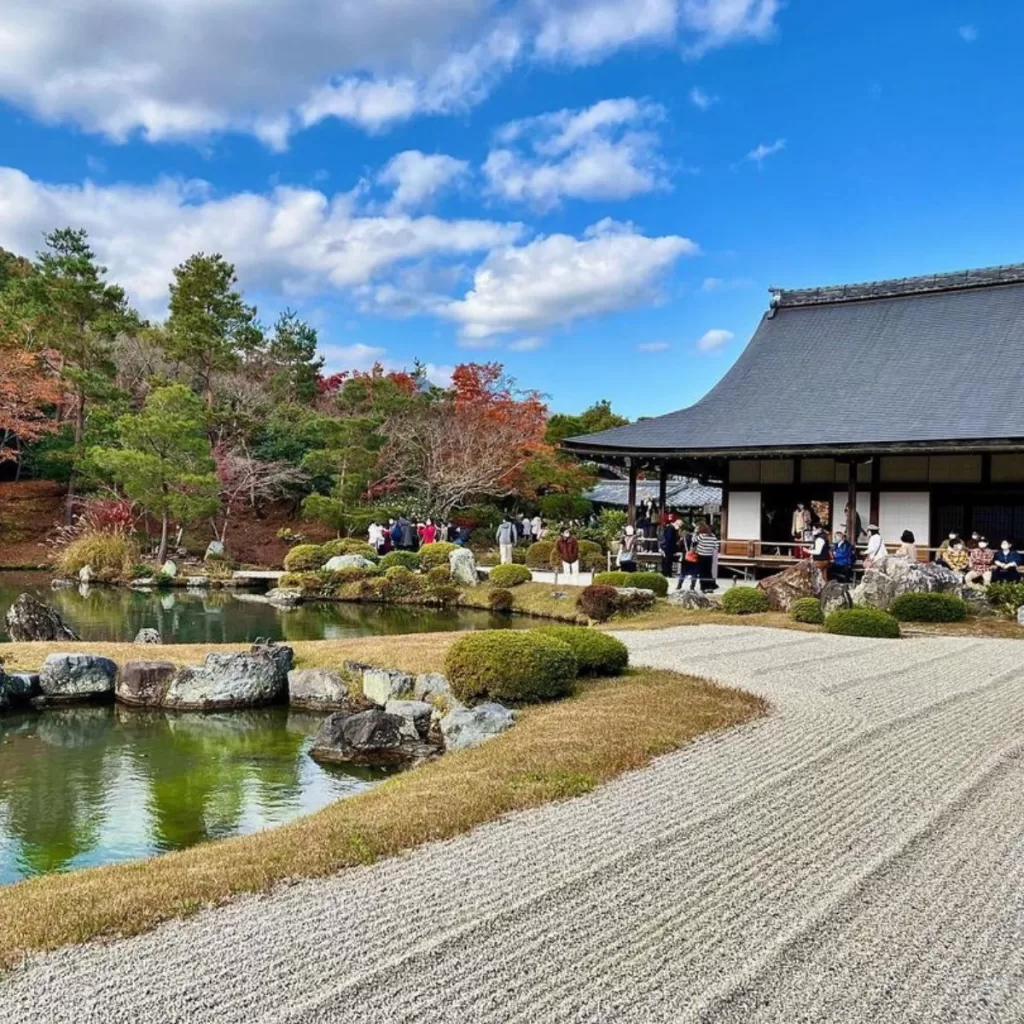
A UNESCO World Heritage site, Tenryu-ji Temple is one of Kyoto’s five great Zen temples and boasts exquisite landscape gardens. Built in 1339, the temple’s remarkable gardens display rock formations, pine trees, and tranquil ponds. Tenryu-ji Temple provides a serene environment for meditation.
Take a leisurely stroll along the winding paths, surrounded by lush greenery, tranquil ponds, and picturesque landscapes. The garden is meticulously designed to create a sense of harmony and peace, providing the perfect setting for reflection and tranquility.
The main hall of Tenryu-ji Temple is a true architectural masterpiece, featuring a traditional Zen design with elegant simplicity. Step inside and be greeted by the sight of the temple’s treasured dragon painting, a symbol of power and wisdom. Take a moment to participate in a Zen meditation session, allowing your mind to find stillness and calm amidst the serene ambiance.
Ninna-ji Temple
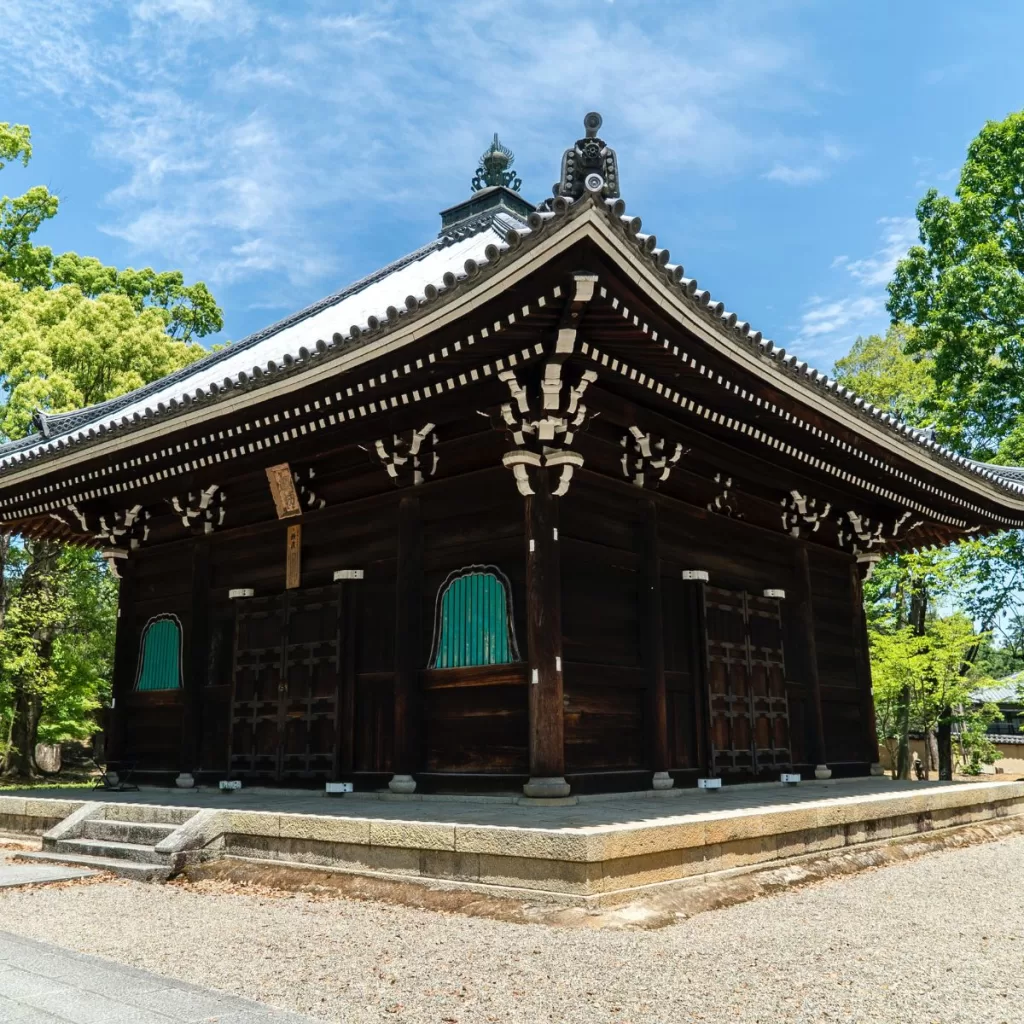
One of Kyoto’s most popular temples in autumn, Ninna-ji Temple is surrounded by maple trees that create vivid displays of fall foliage. Ninna-ji is one of the head temples of the Omuro school of the Shingon Sect of Buddhism. The temple has ornate interiors and detailed wood carvings not to be missed.
This historic temple is known for its serene atmosphere and beautifully preserved buildings. As you enter the temple grounds, you’ll be greeted by the tranquil gardens and picturesque scenery that transport you back in time. Take a leisurely walk through the peaceful pathways, surrounded by lush greenery and traditional Japanese architecture.
One of the main attractions of Ninna-ji Temple is its magnificent five-story pagoda, standing tall and majestic against the sky. This iconic structure is a symbol of Buddhist spirituality and offers a breathtaking view of the surrounding landscape. Marvel at the intricate design and craftsmanship that went into creating this architectural masterpiece.
Toei Kyoto Studio Park
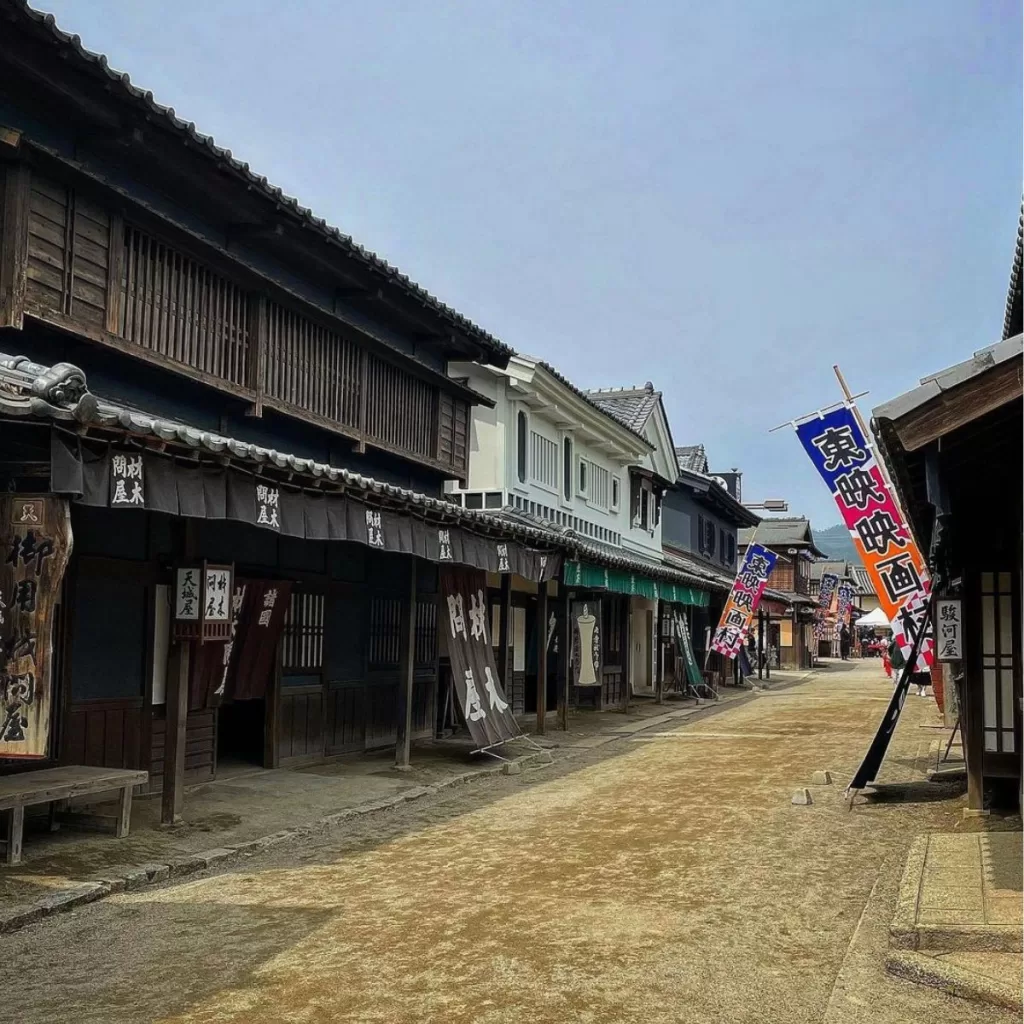
Explore Japan’s magical world of film at Toei Kyoto Studio Park. This movie theme park was once an actual film studio and maintains some of the Edo period sets. Try on costumes, watch shows, and tour the interior of a Japanese home from the 1500s recreated in detail. Fans of samurai movies and anime will especially appreciate this attraction.
As you walk through the streets of Toei Kyoto Studio Park, you’ll feel like you’ve traveled back in time. Immerse yourself in the bustling atmosphere of old Kyoto, filled with samurai warriors, geishas, and merchants. Take a break from reality and watch thrilling ninja shows, sword fights, and theatrical performances that showcase the skills of these historical characters. Be sure to visit the various interactive attractions where you can try your hand at throwing shurikens or shooting arrows like a samurai.
Come to Toei Kyoto Studio Park and embark on a journey through time. It’s an exciting and educational experience that will entertain visitors of all ages. Get ready for an action-packed adventure, immerse yourself in the vibrant world of historical Japan, and create memories that will last a lifetime.
Higashiyama District
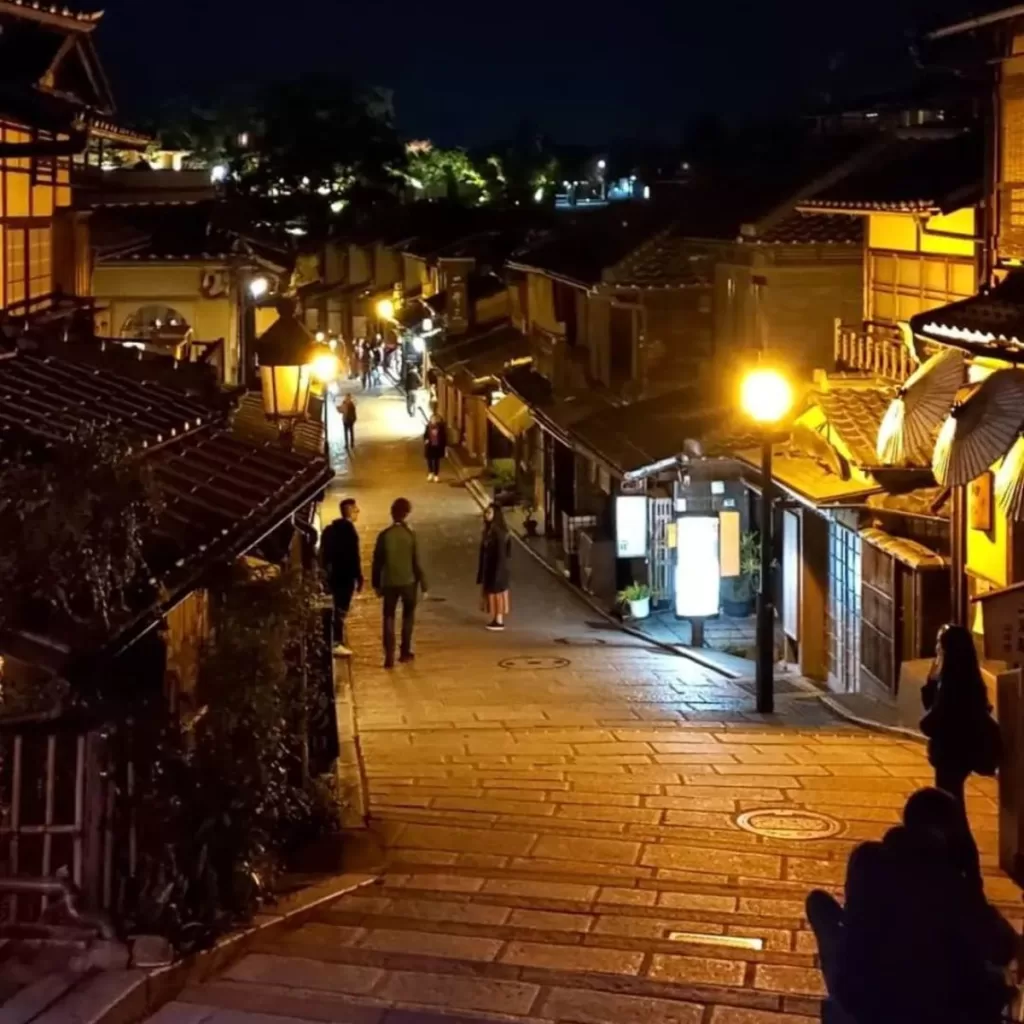
For traditional shops, temples, and a preserved historic atmosphere, take a stroll through Higashiyama District. Along the narrow lanes, you’ll find pottery shops, sweet shops, and small museums.
This historic neighborhood is a treasure trove of temples, shrines, artisan shops, and teahouses, providing a delightful blend of sights, sounds, and flavors.
Immerse yourself in the beauty of Higashiyama’s ancient temples and shrines. From the iconic Kiyomizu-dera Temple with its stunning wooden terrace to the peaceful Yasaka Shrine adorned with lanterns, you’ll be captivated by their intricate architecture and serene atmosphere. Take a moment to reflect and bask in the spiritual energy that permeates these sacred sites.
Entoku-in Temple
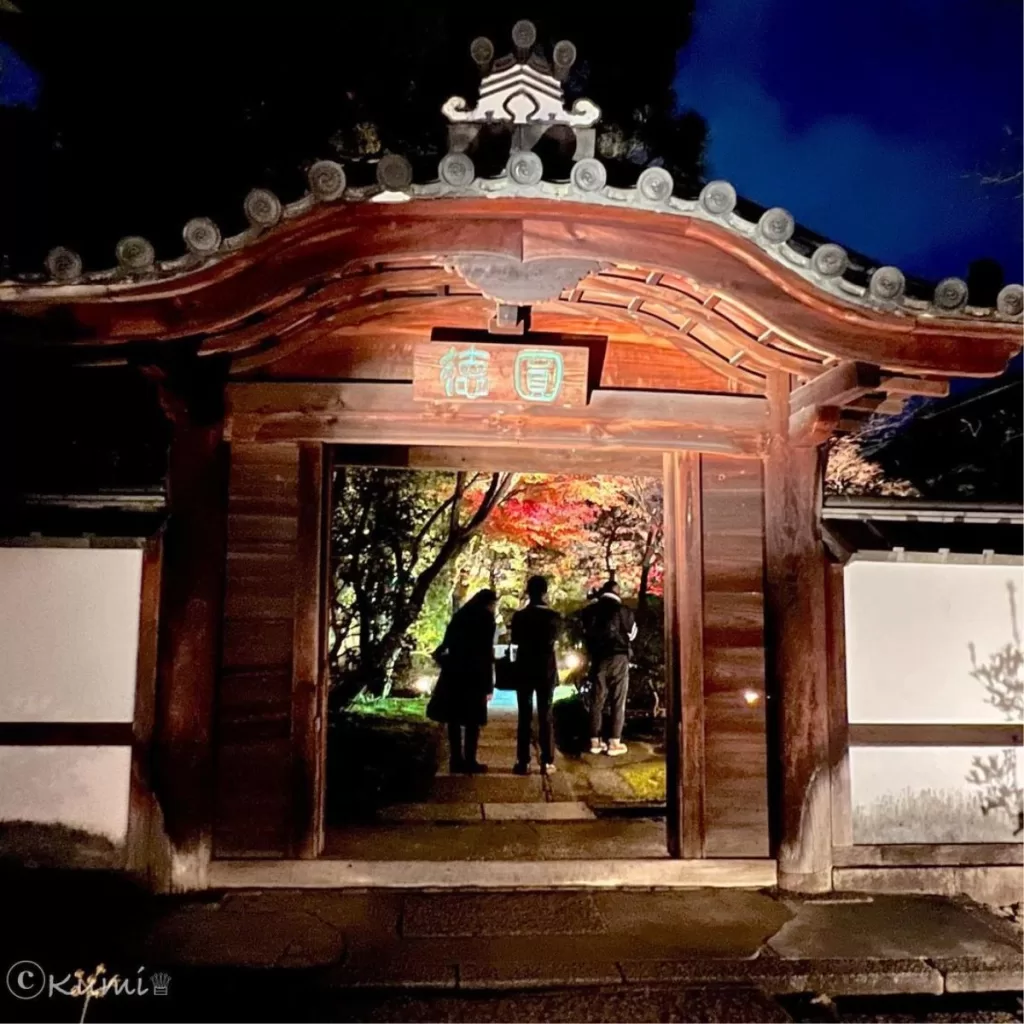
Entoku-in Temple is tucked away in the bamboo forests of Arashiyama. Founded in 1601, it honors Hideyoshi’s life. It contains fusuma painting masterpieces and a zen sand garden designed by famous poet and landscape architect Enshu Kobori. Surrounded by bamboo groves overlooking the Oi River, it’s a hidden retreat.
As you step into the temple grounds, you’ll be greeted by a stunning moss garden, peaceful rock formations, and a picturesque pond, creating a peaceful oasis that soothes the soul.
Entoku-in Temple is renowned for its exquisite Japanese tea house, where visitors can witness and participate in a traditional tea ceremony. Immerse yourself in the ritualistic art of tea preparation as you sip on a warm cup of matcha, appreciating each subtle flavor and the peaceful ambiance that surrounds you. It’s a unique cultural experience that encapsulates the essence of Japanese tea culture.
Chion-in Temple
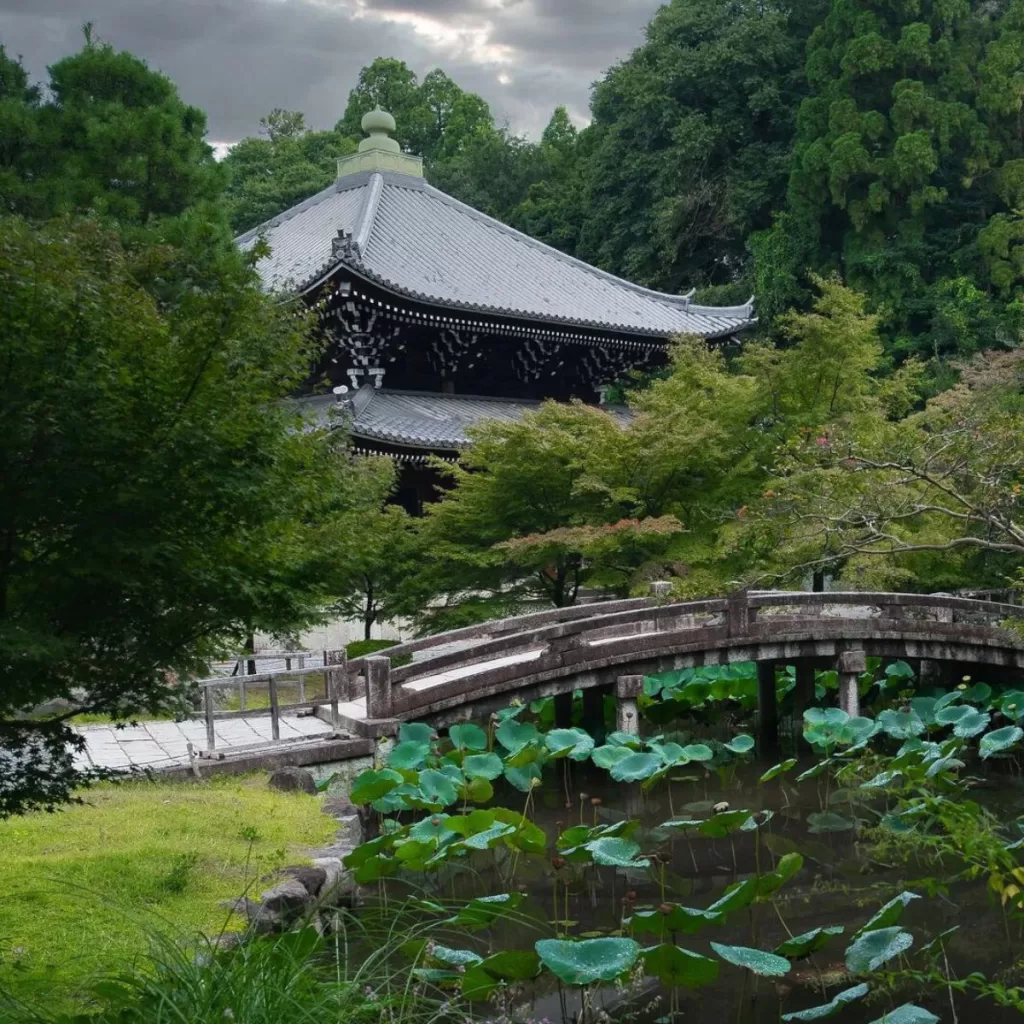
One of the most famous temples in Kyoto, Chion-in Temple was built in 1234. The temple is grand in scale, known for being the headquarters of the Jodo sect of Buddhism. Walk up nightingale floors to the huge temple bell and admire views of Kyoto from the observation deck.
One of the highlights of Chion-in Temple is its main hall, where you’ll find the largest wooden gate in Japan. Marvel at the imposing architecture and richly adorned interior as you explore the spacious halls and contemplate the profound teachings of Buddhism. Don’t miss the opportunity to witness a Buddhist ceremony taking place, where you can observe monks chanting and experience a sense of spiritual enlightenment.
Visit Chion-in Temple and embark on a spiritual journey that will leave you with a profound sense of awe and reverence. It’s a place where history and spirituality collide, and where visitors can find solace in the tranquility of their surroundings.
Yasaka Shrine
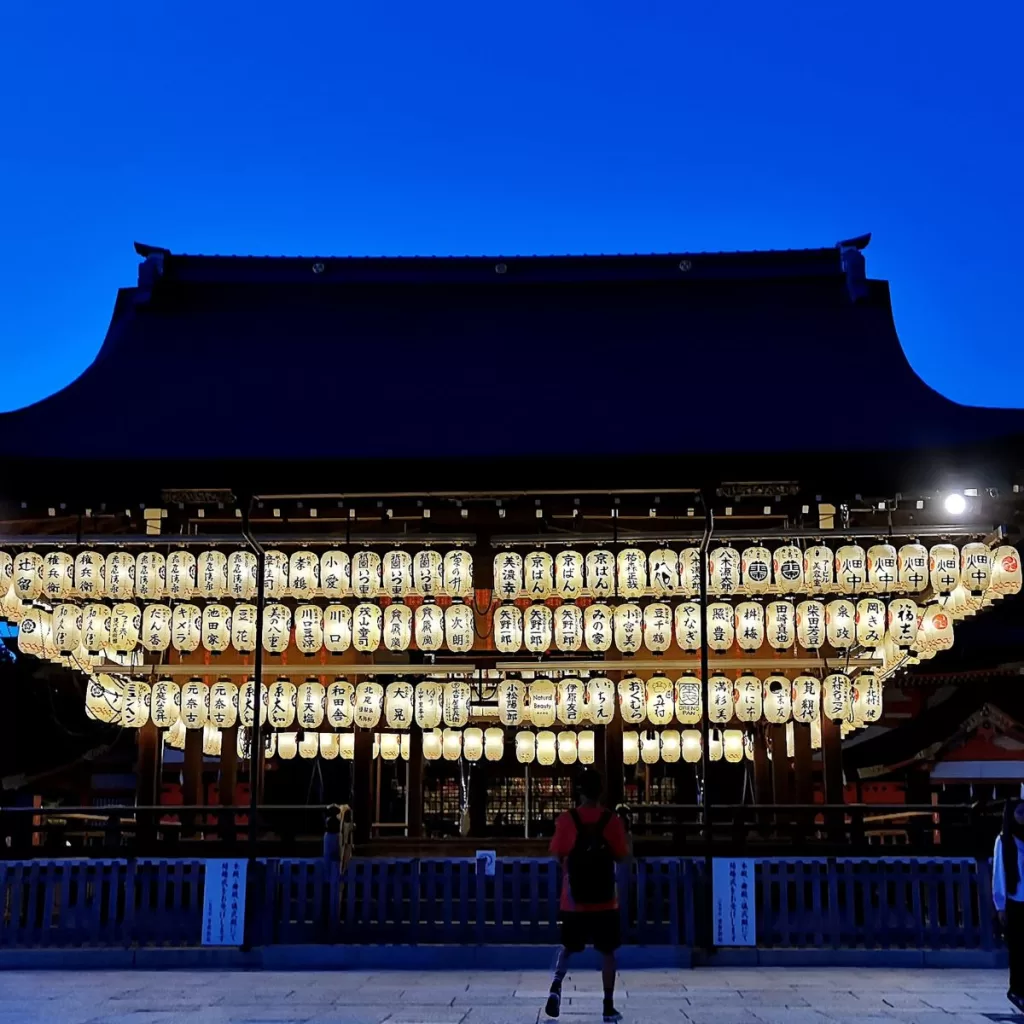
At the east end of Shijo-dori, the large vermillion Yasaka Shrine is a beautiful shrine in the heart of Kyoto’s Gion area. Founded over 1350 years ago, it houses many festivals and events throughout the year. The shrine’s lantern-lit stone stairway creates a magical scene at night.
Yasaka Shrine is not just a place of worship; it’s also a hub of cultural activities and festivals. Throughout the year, the shrine hosts exciting events that showcase traditional music, dance, and rituals.
Don’t miss the opportunity to witness and participate in these vibrant celebrations that bring the spirit of Kyoto to life. Visit Yasaka Shrine and experience the essence of Kyoto’s spirituality and cultural traditions. Whether you’re seeking a moment of reflection, a glimpse into Japan’s heritage, or simply a captivating place to explore, Yasaka Shrine offers a memorable and enchanting experience for visitors of all backgrounds.
Kyoto Station Building
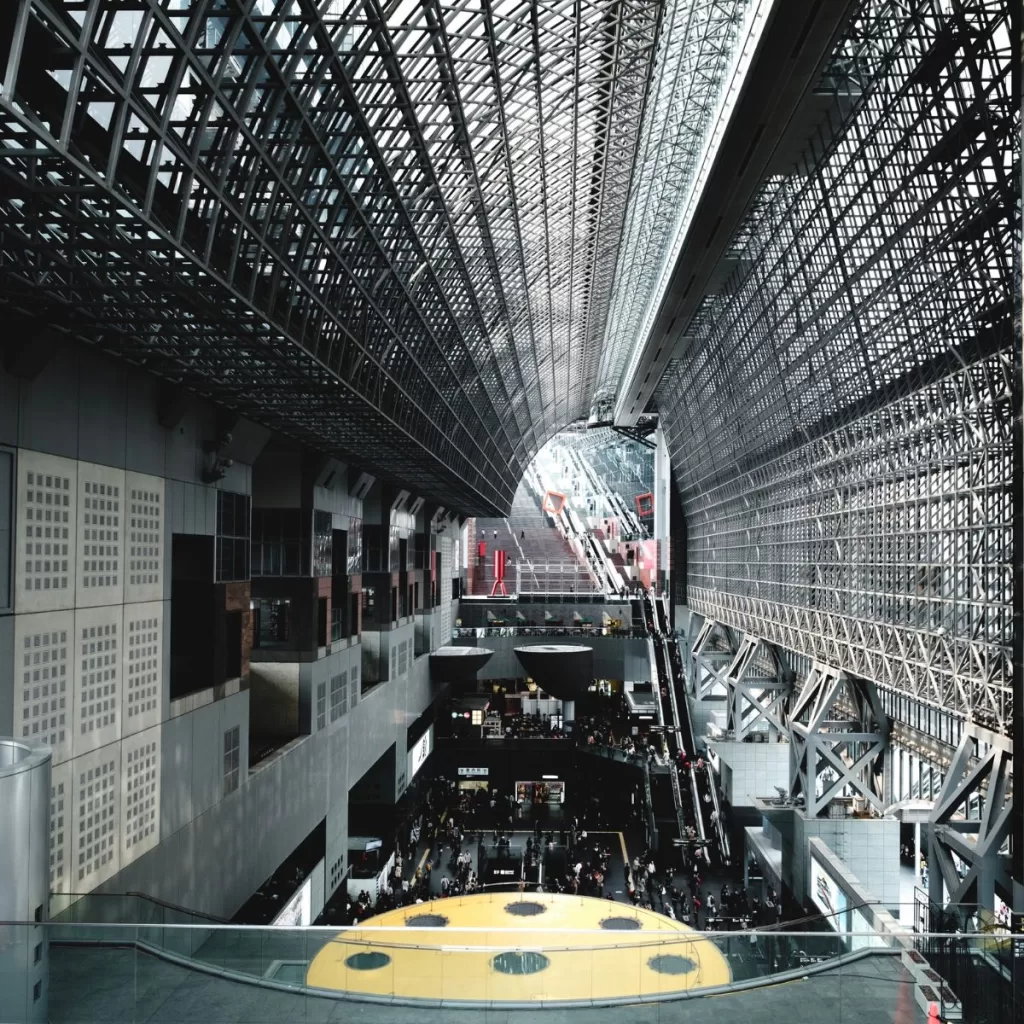
It is a true architectural masterpiece that serves as the gateway to the historic city of Kyoto. As you approach the station, you’ll be captivated by its modern and futuristic design, blending seamlessly with the traditional charm of Kyoto. Step inside and immerse yourself in a world of bustling activity and endless opportunities for exploration.
The Kyoto Station Building is not just a transportation hub; it’s also a destination in itself. With its vast shopping complex, delicious dining options, and cultural attractions, there’s something for everyone to enjoy. Indulge in a shopping spree at the numerous boutiques and department stores, or sample a variety of local delicacies at the food court. Climb to the top of the observation deck for panoramic views of the city, or explore the underground museum showcasing the history and culture of Kyoto.
Plan your visit to Kyoto Station Building and be prepared for a captivating experience. Whether you’re a shopaholic, a food lover, or simply interested in witnessing the fusion of tradition and modernity, Kyoto Station Building offers a vibrant and engaging environment that showcases the best of Kyoto.